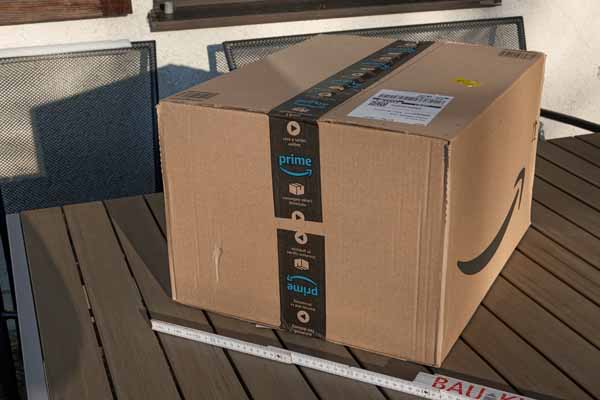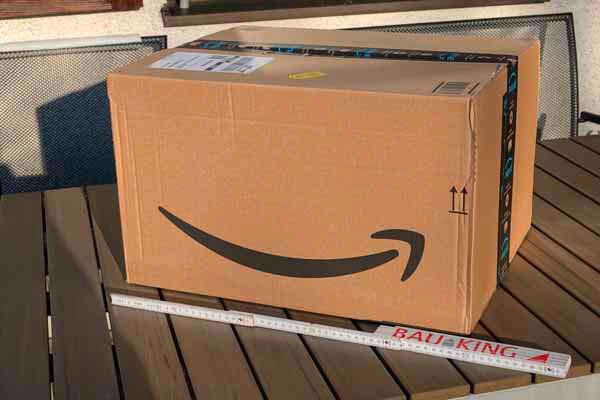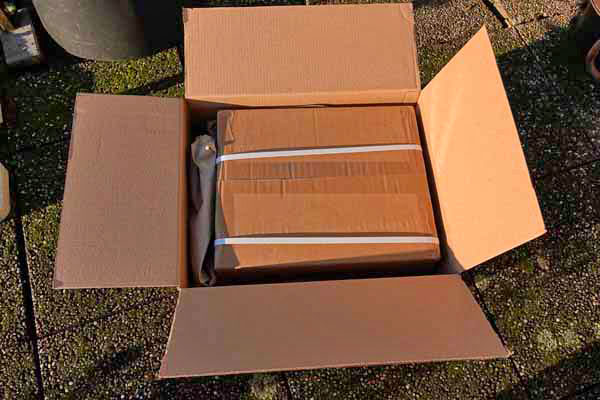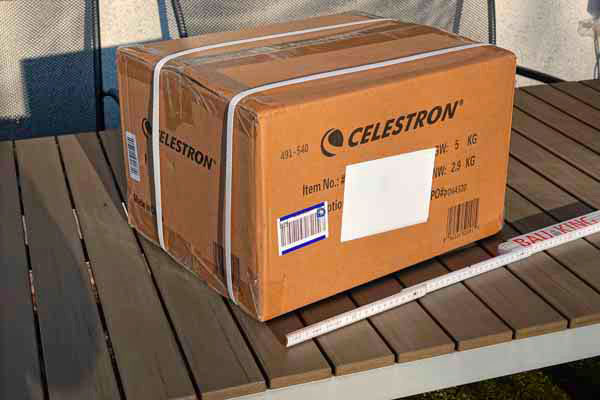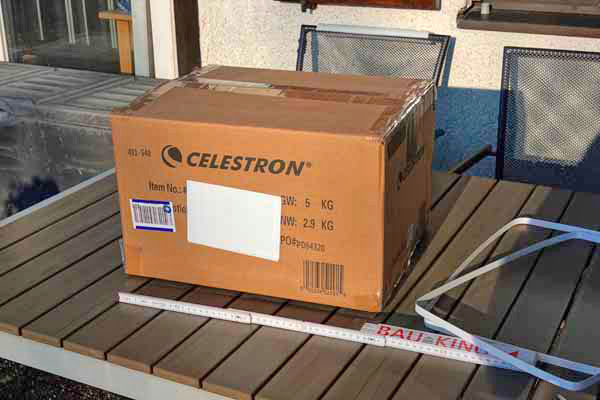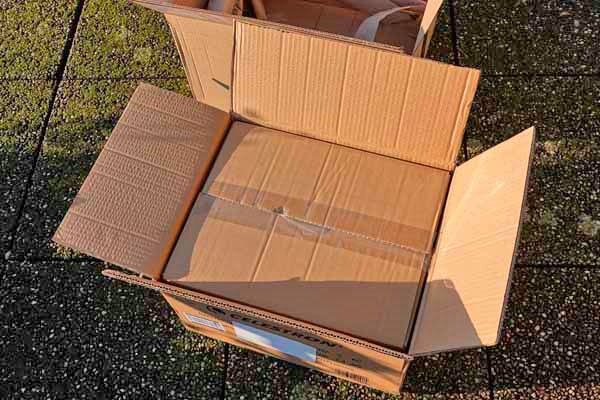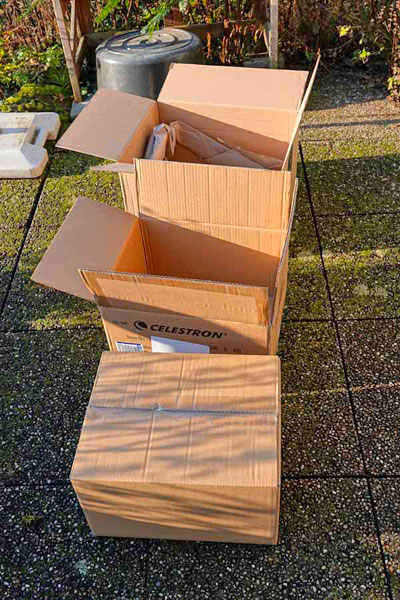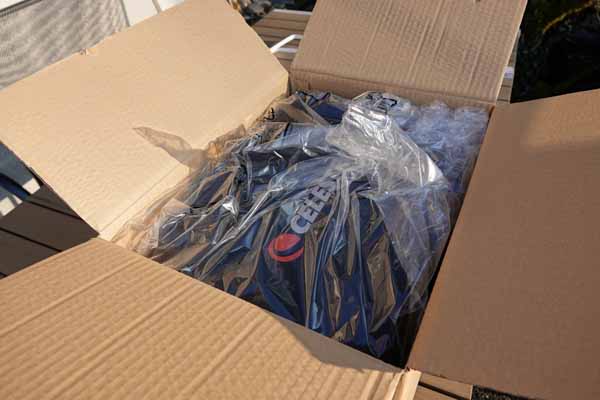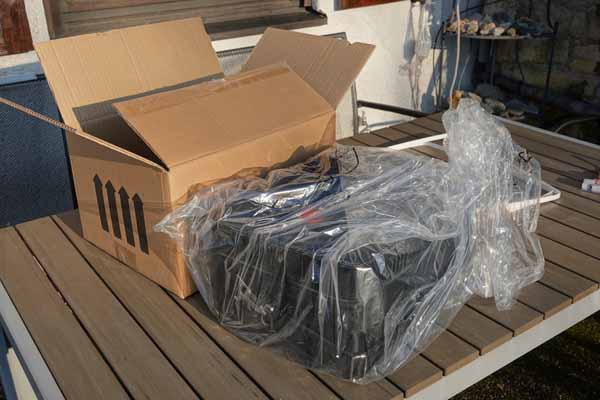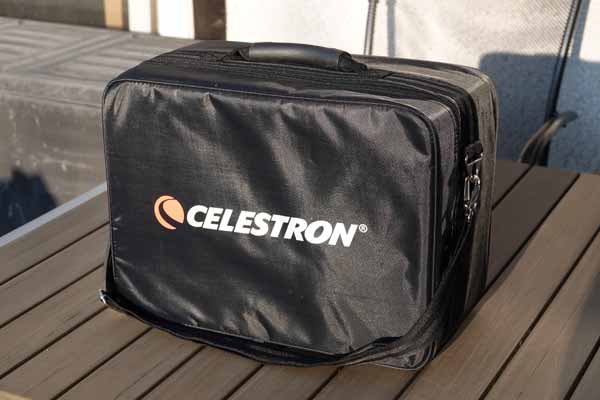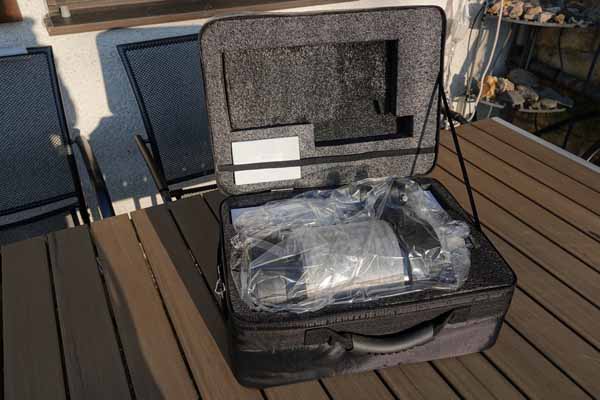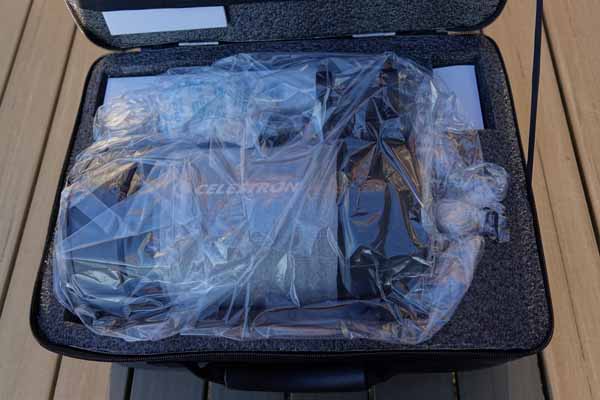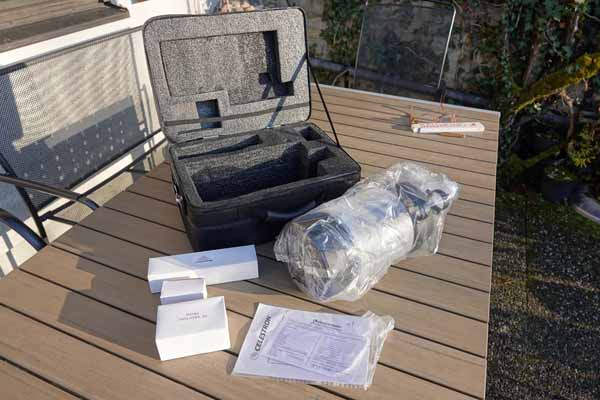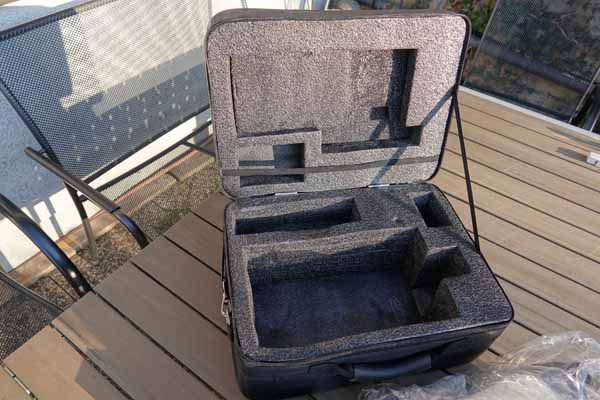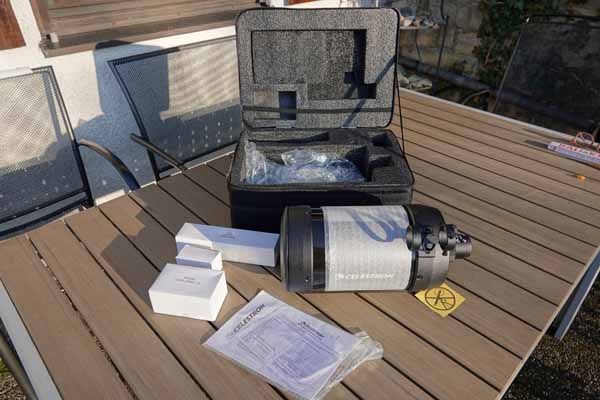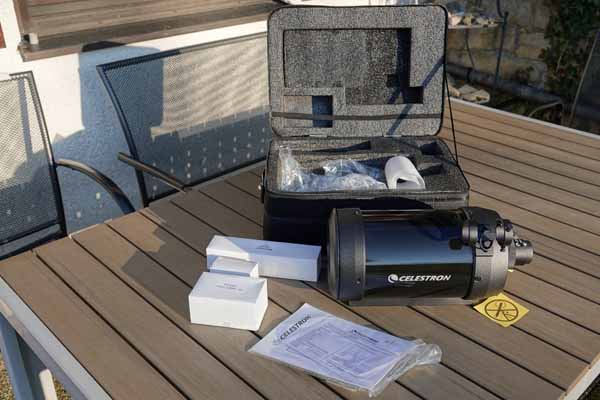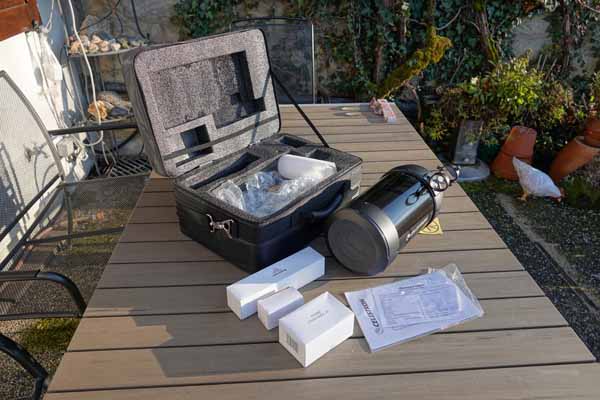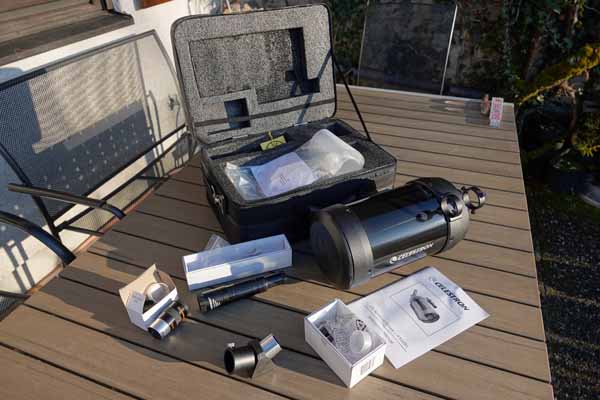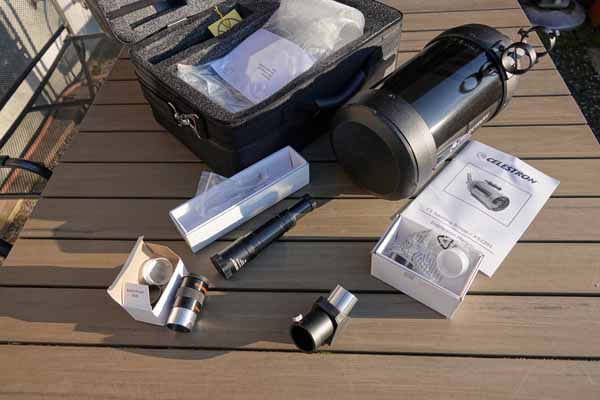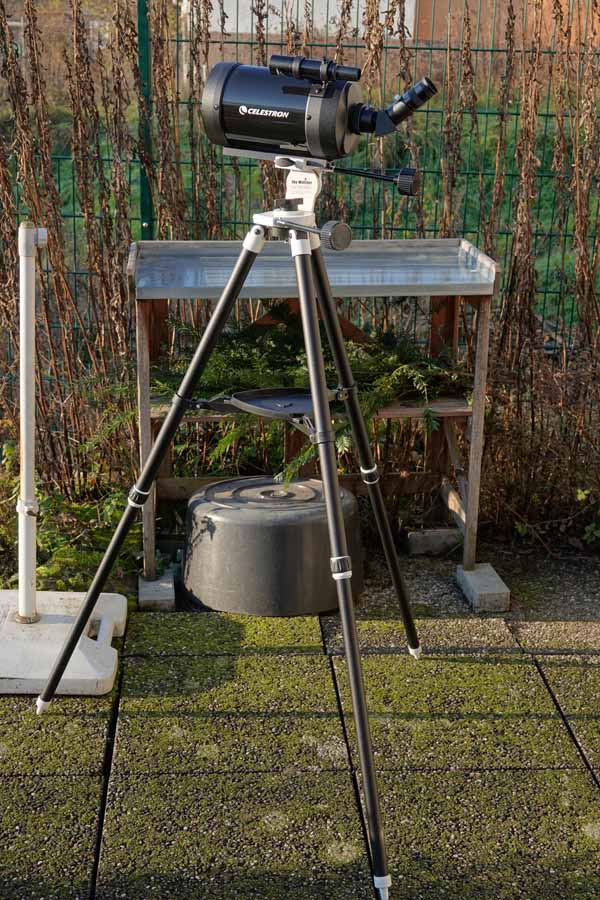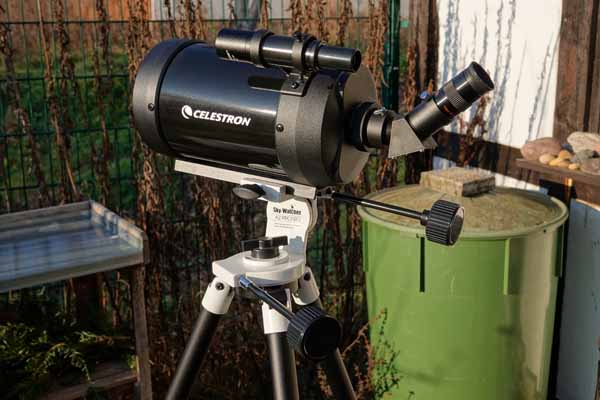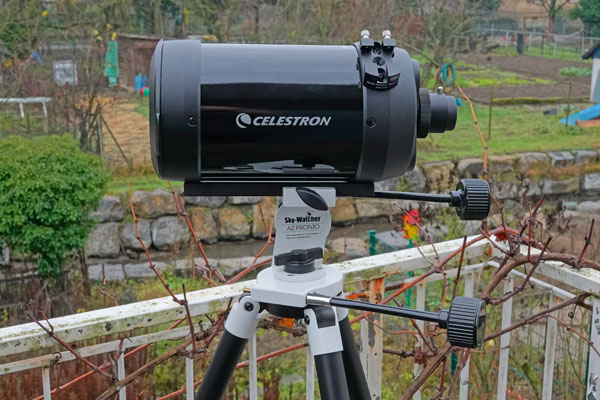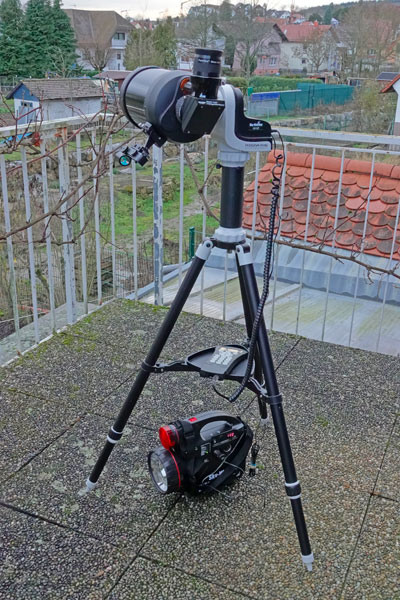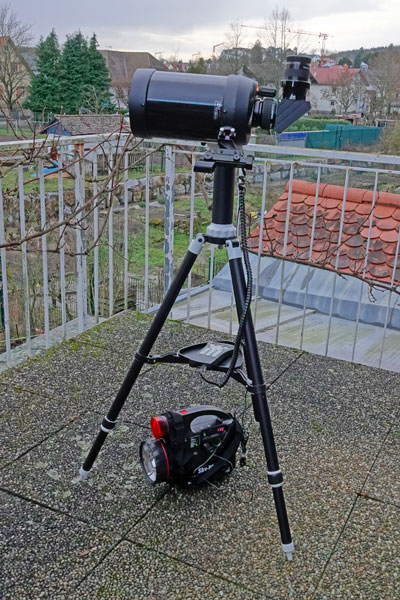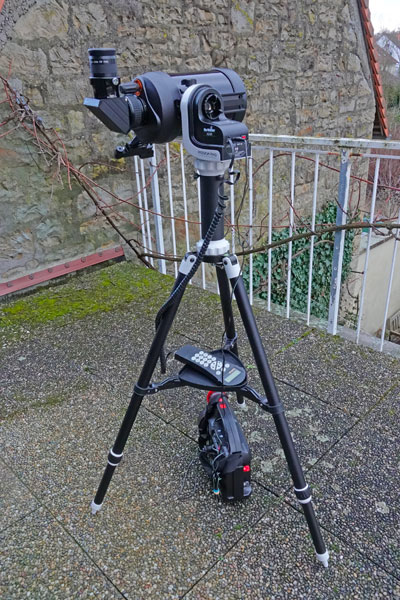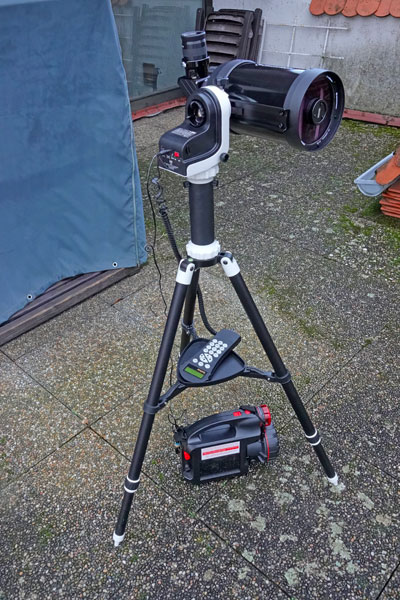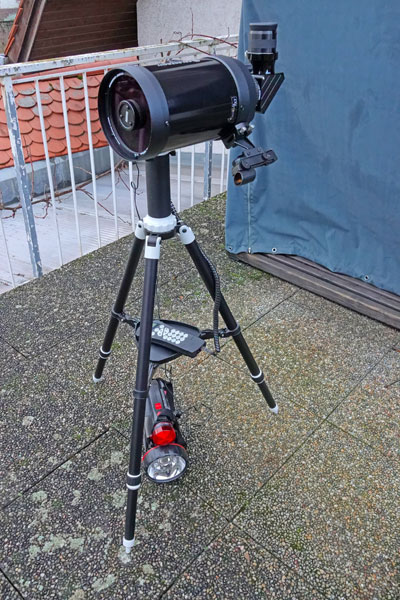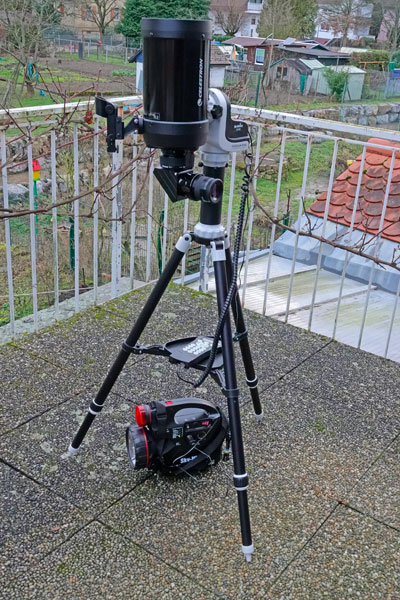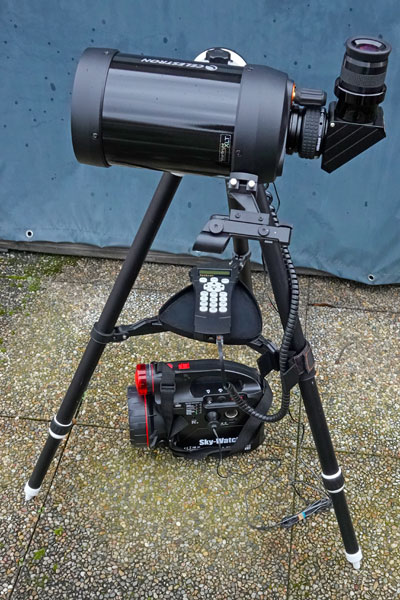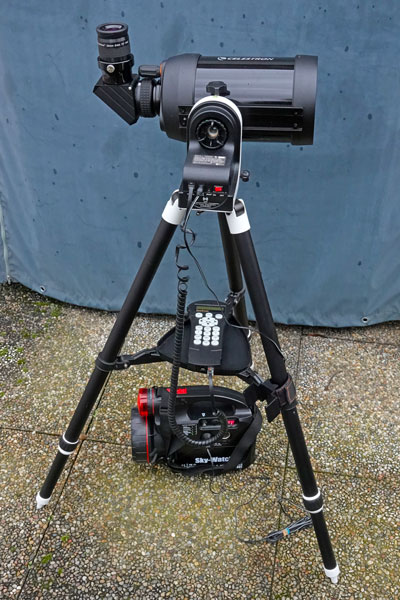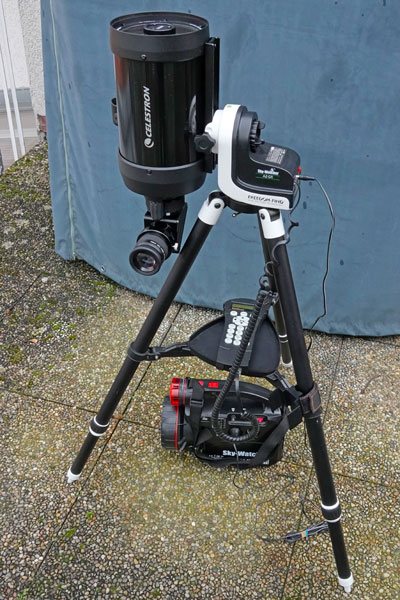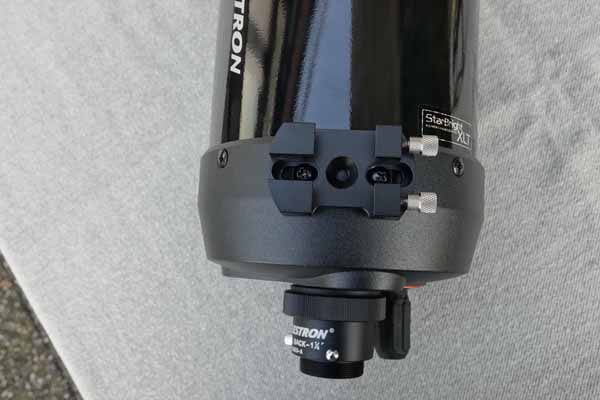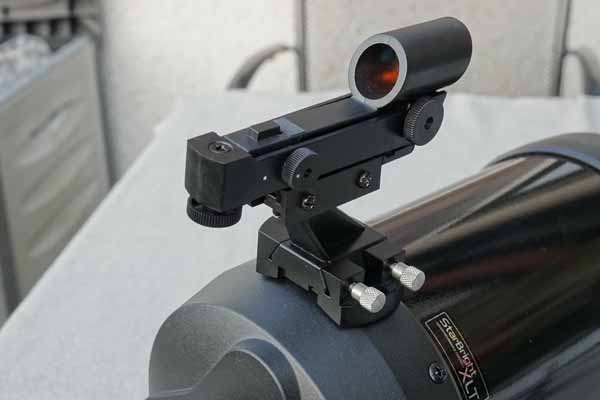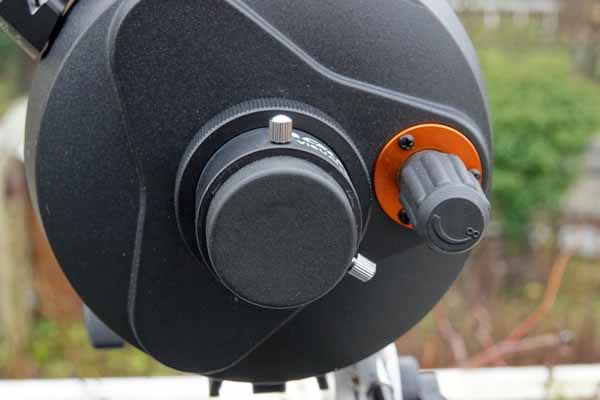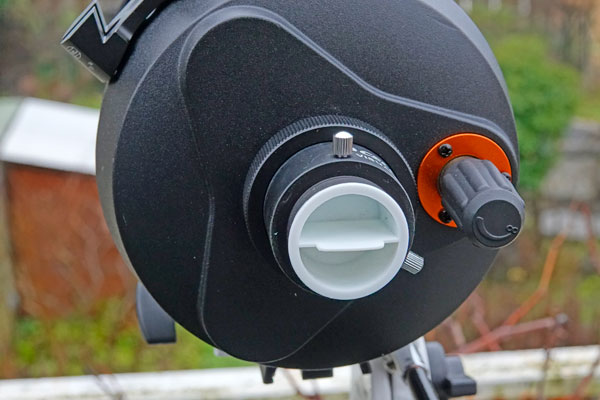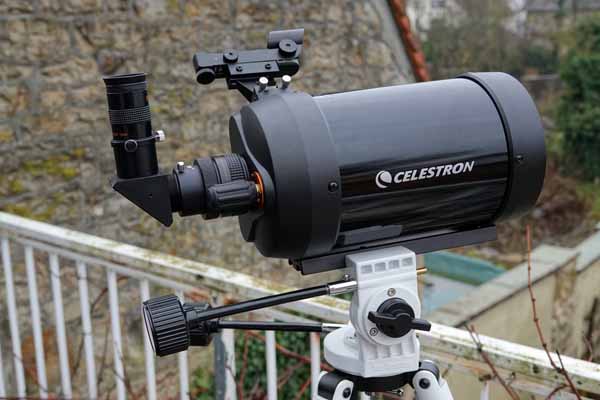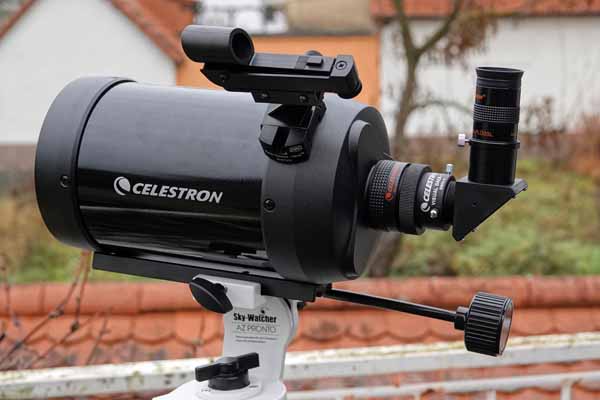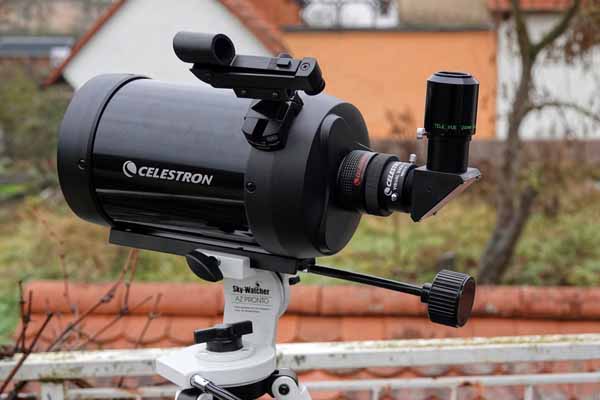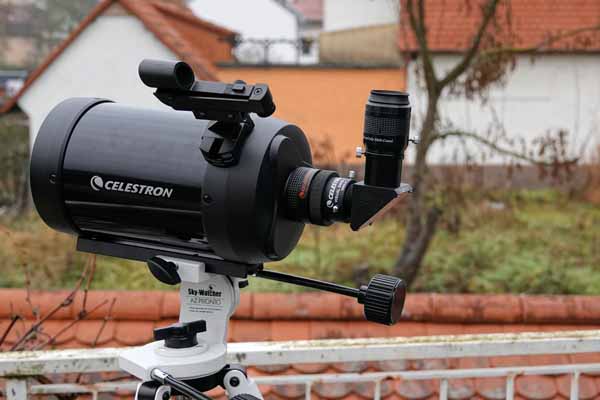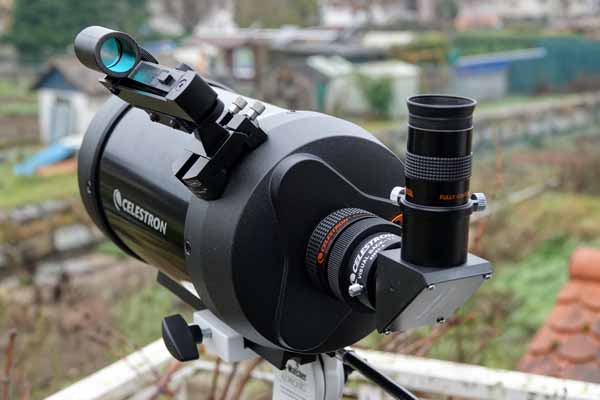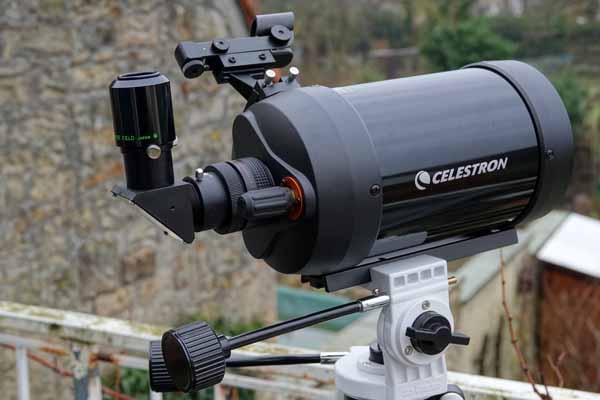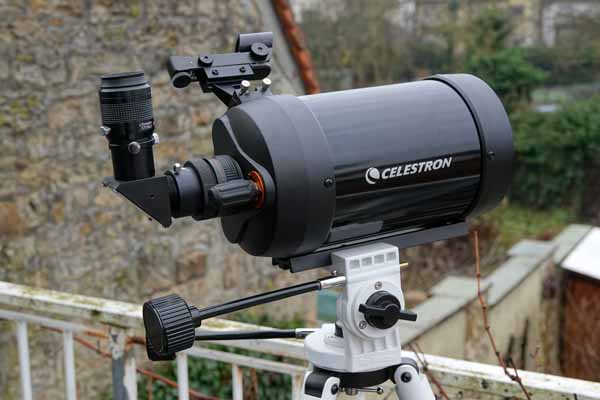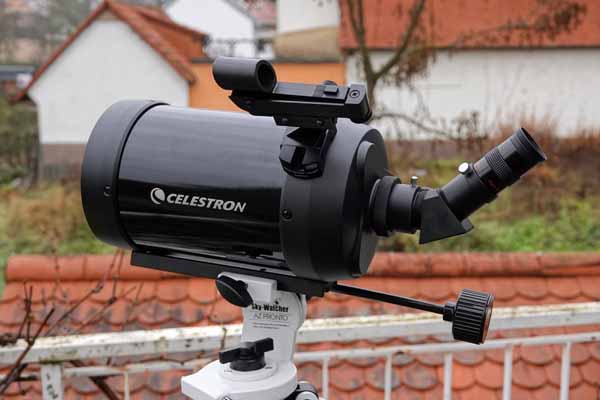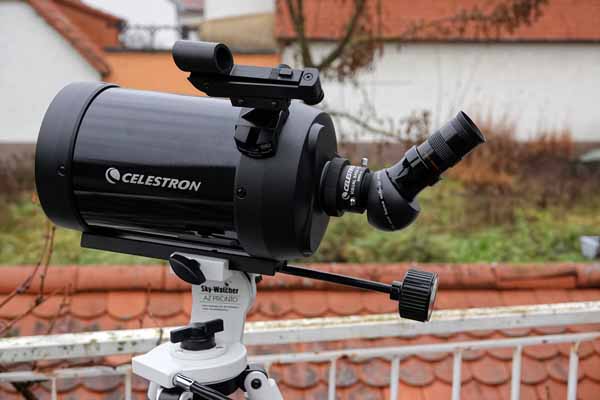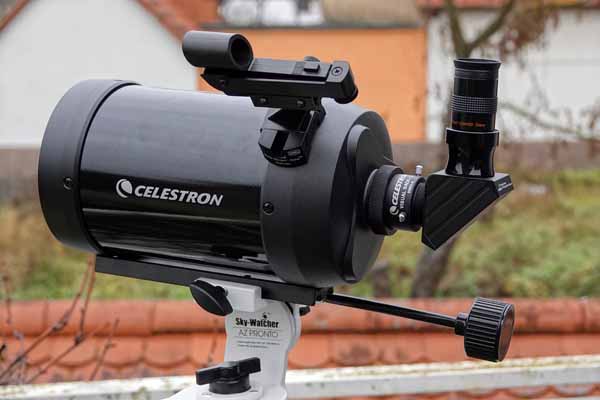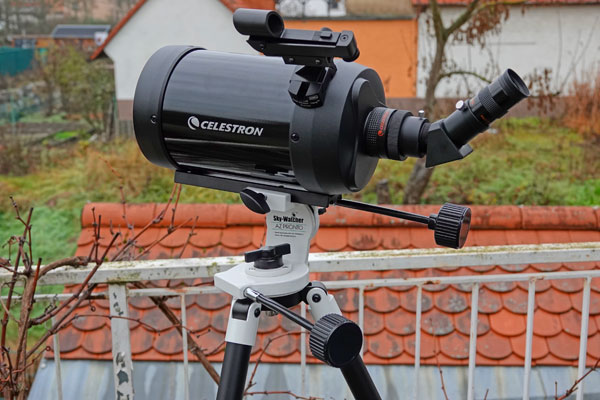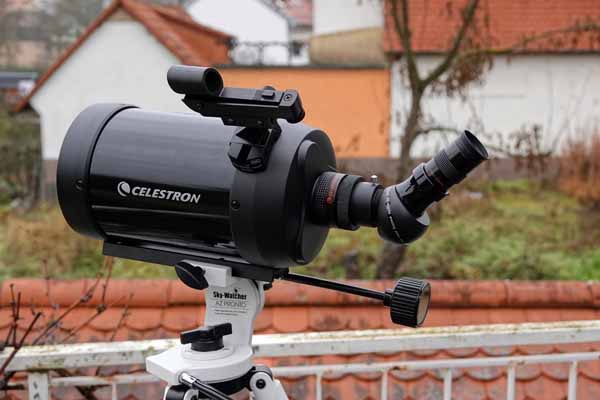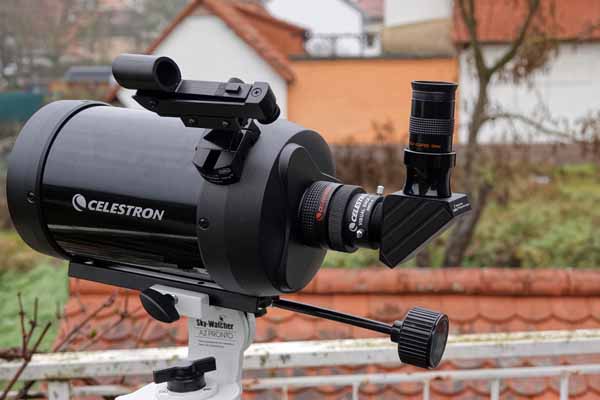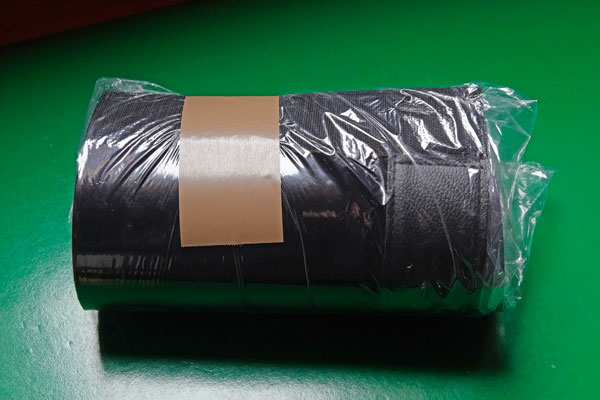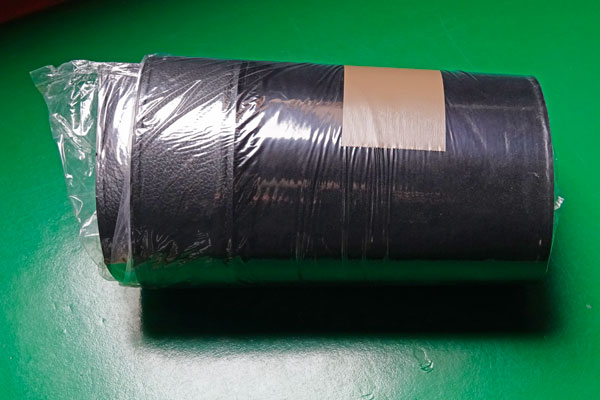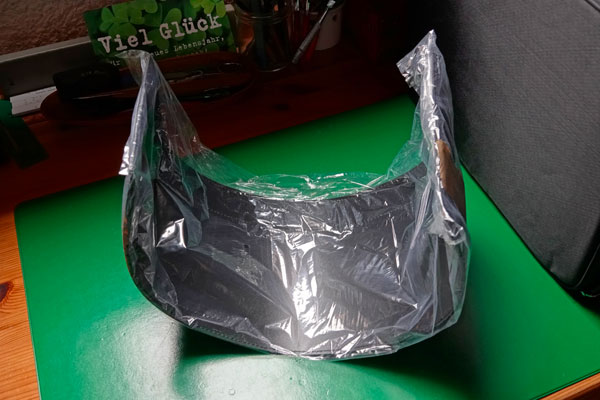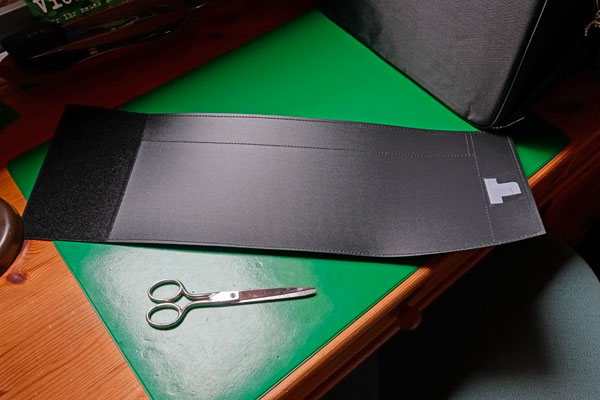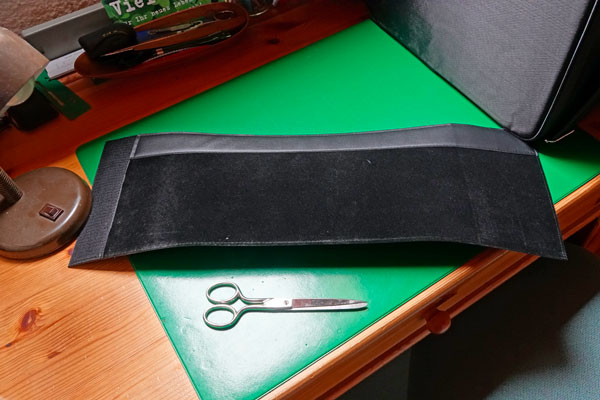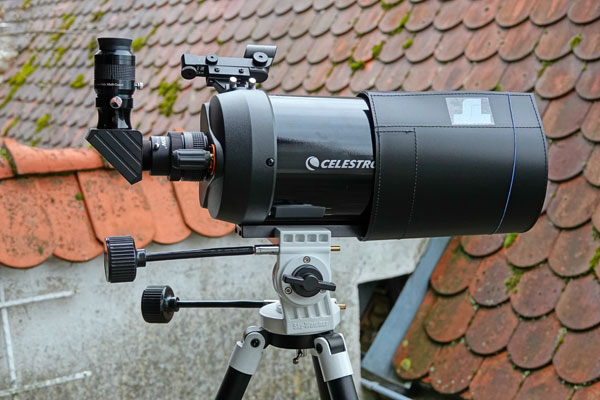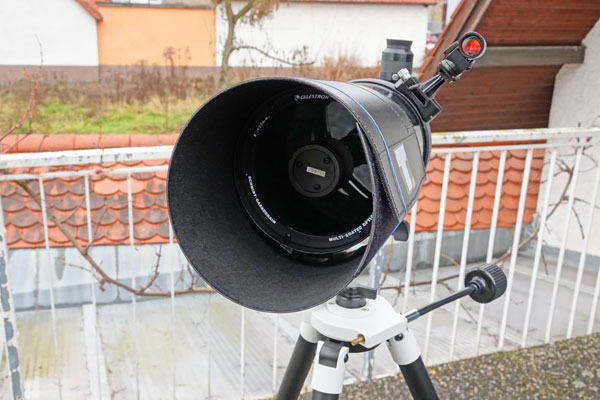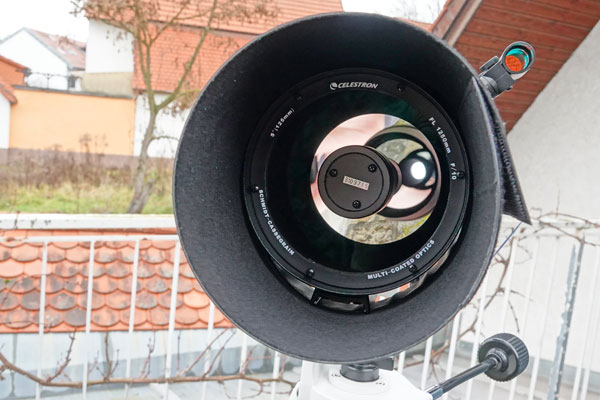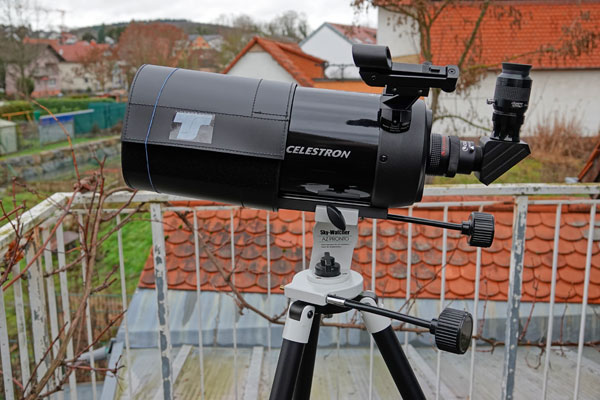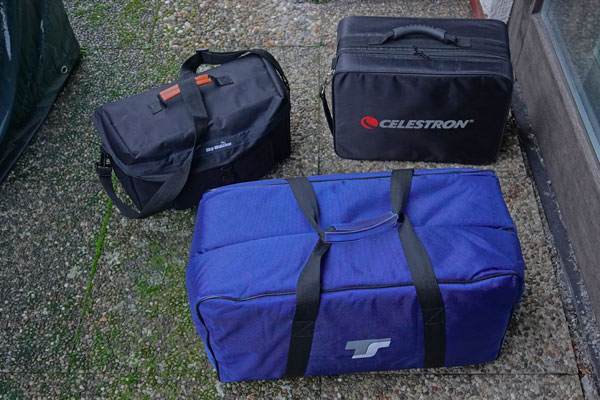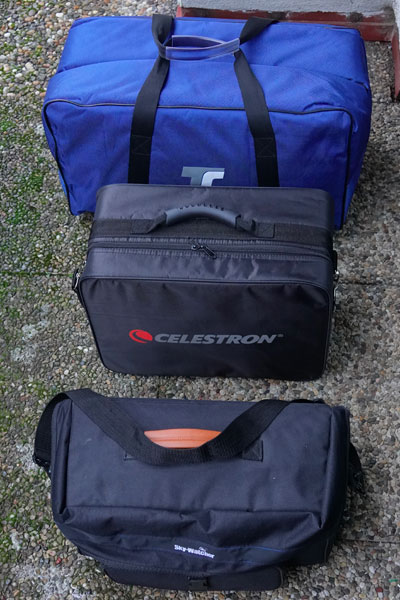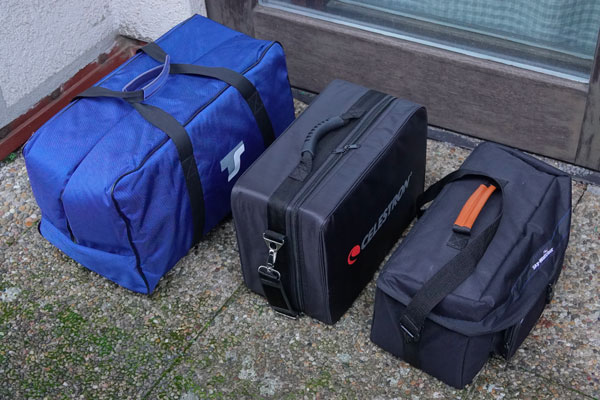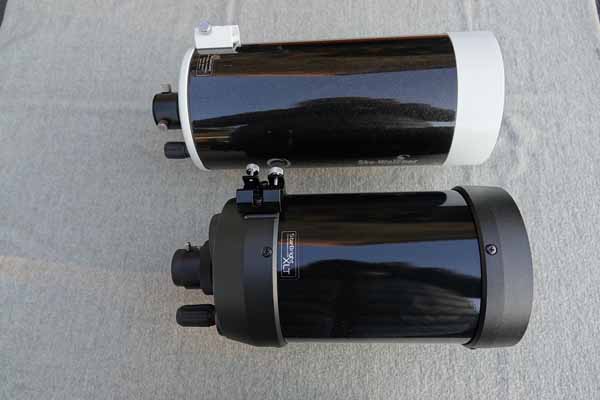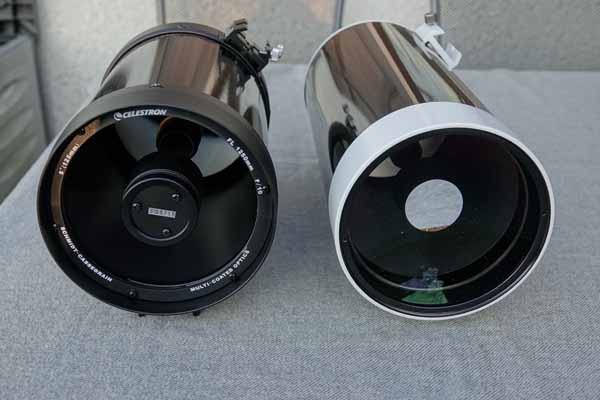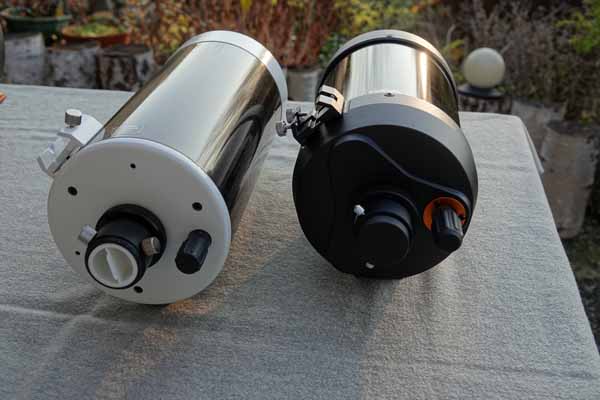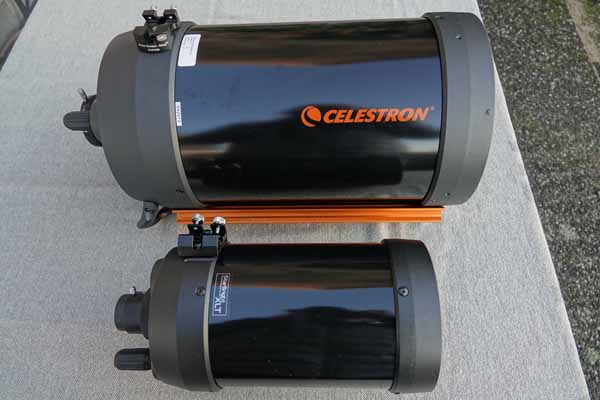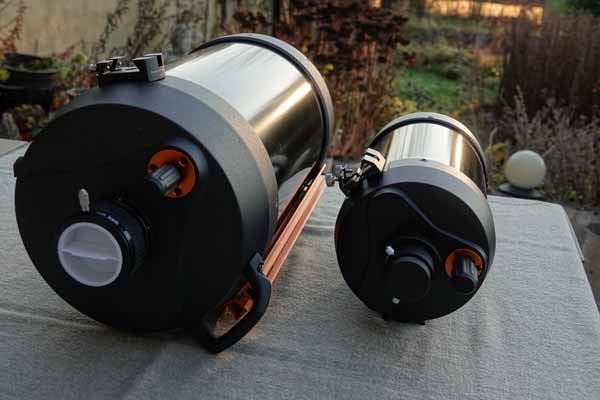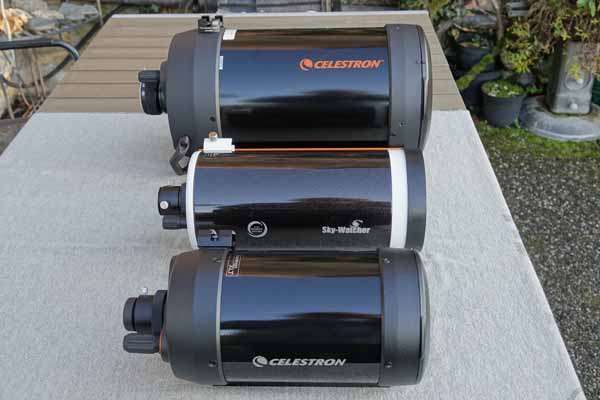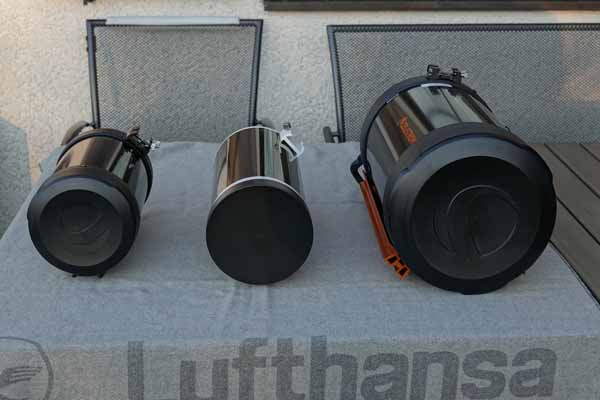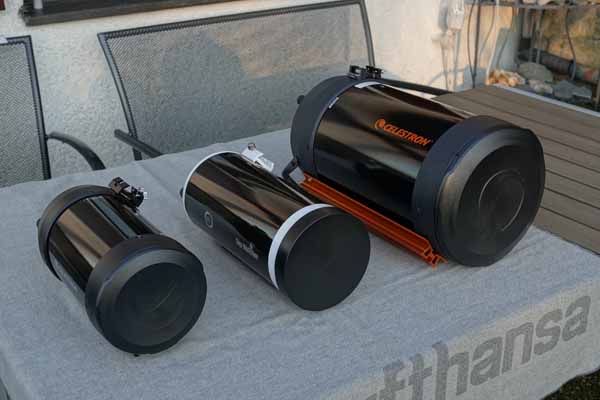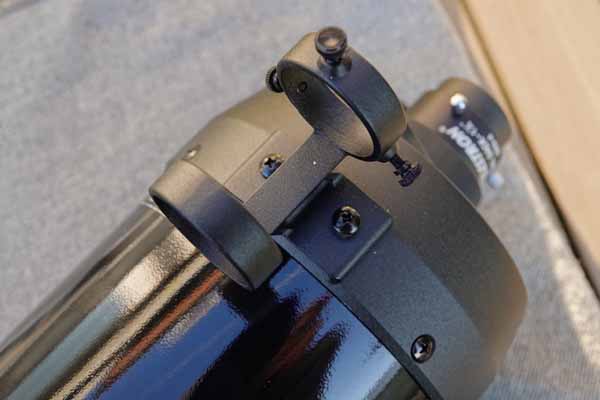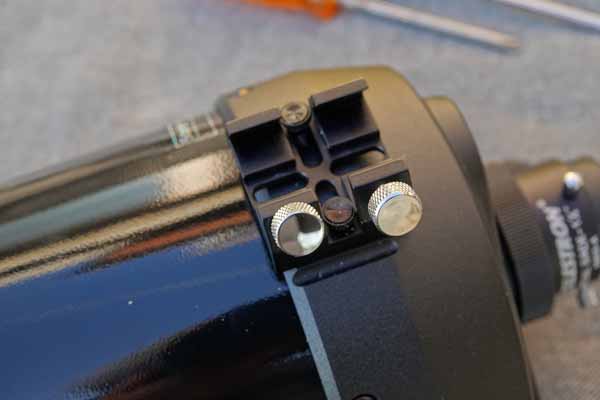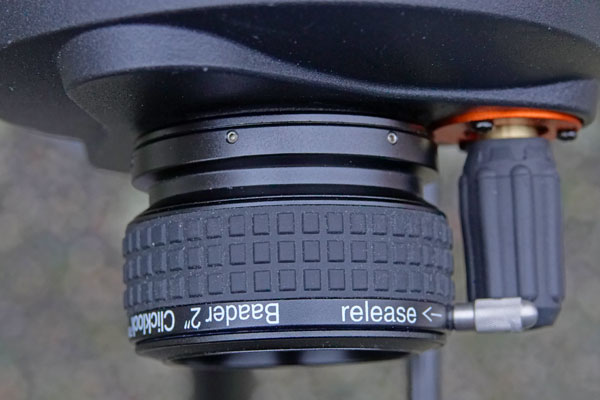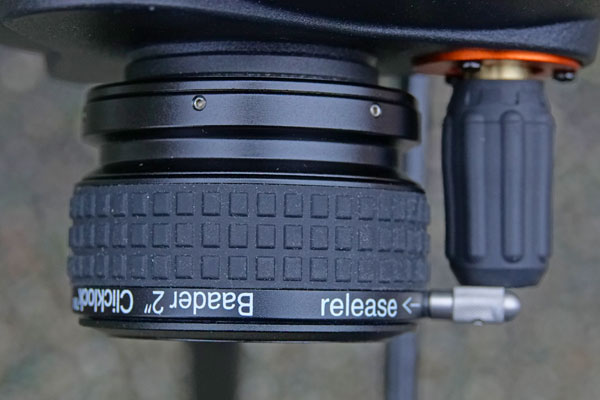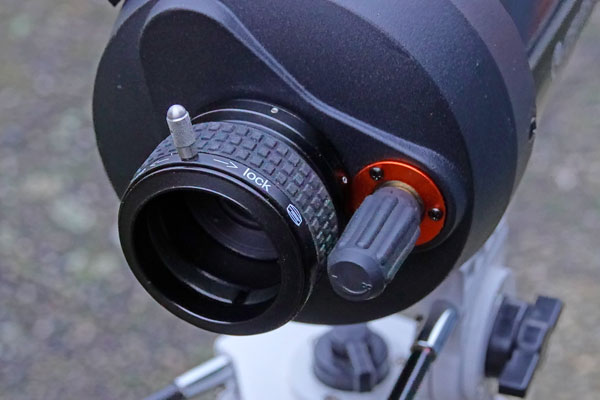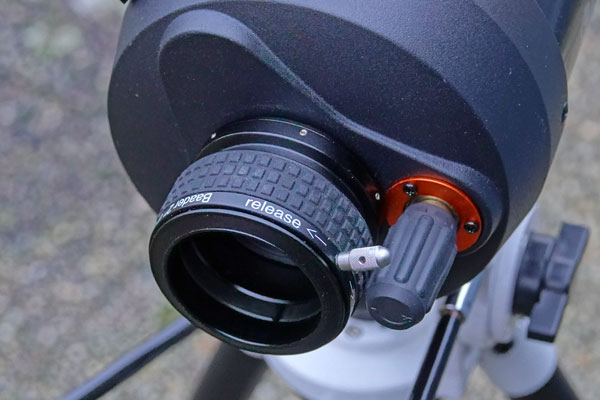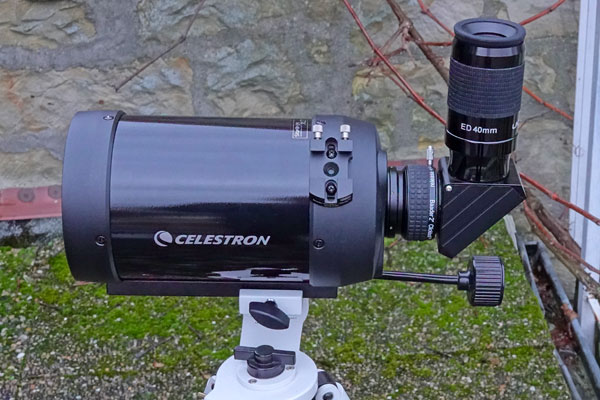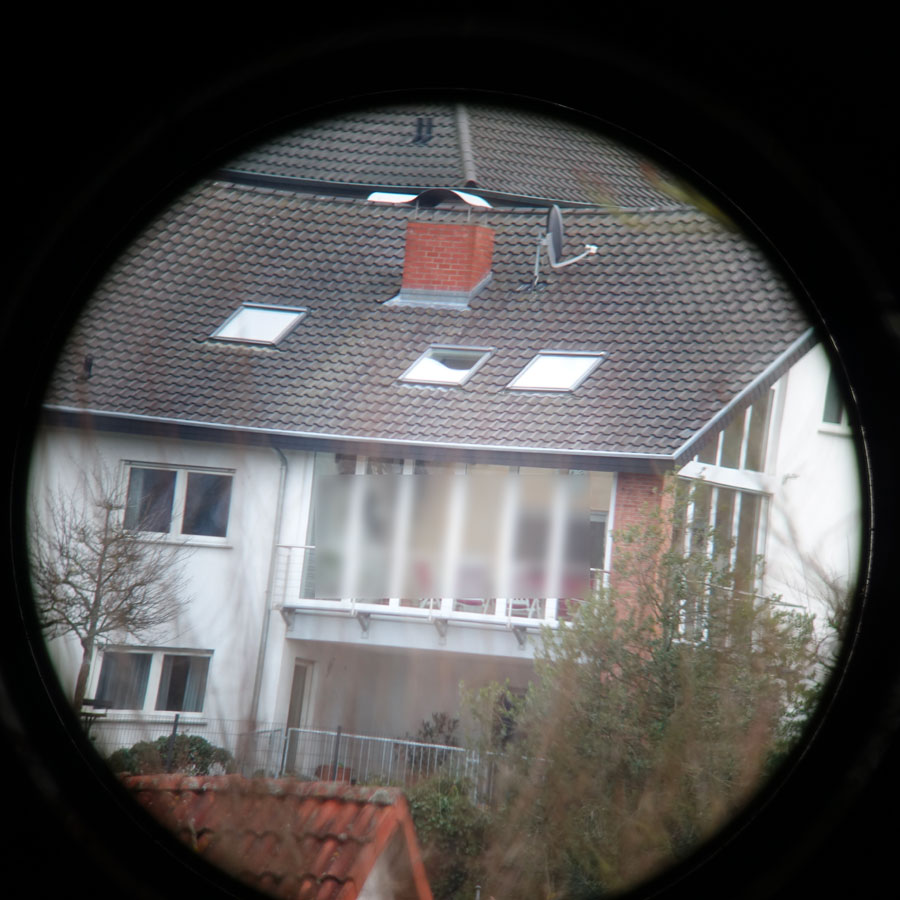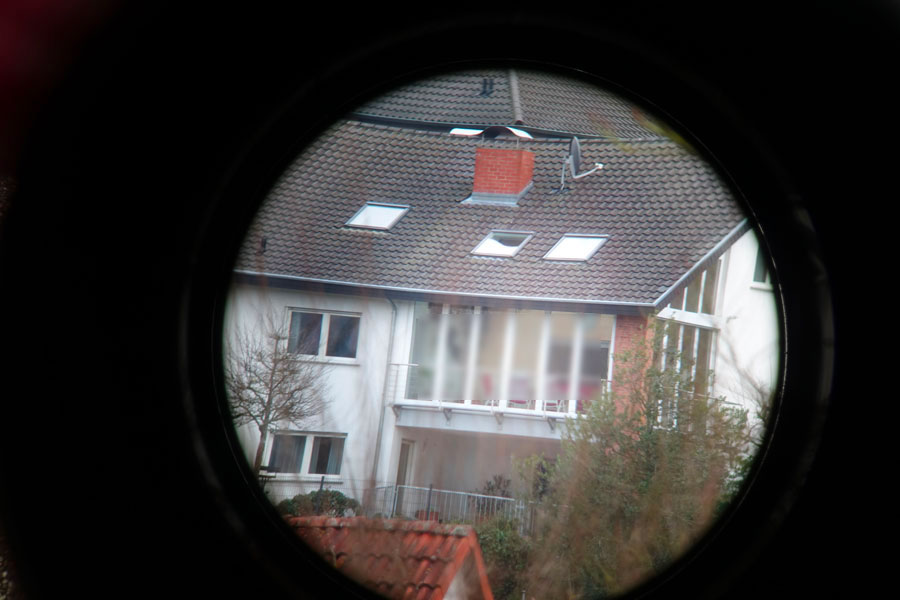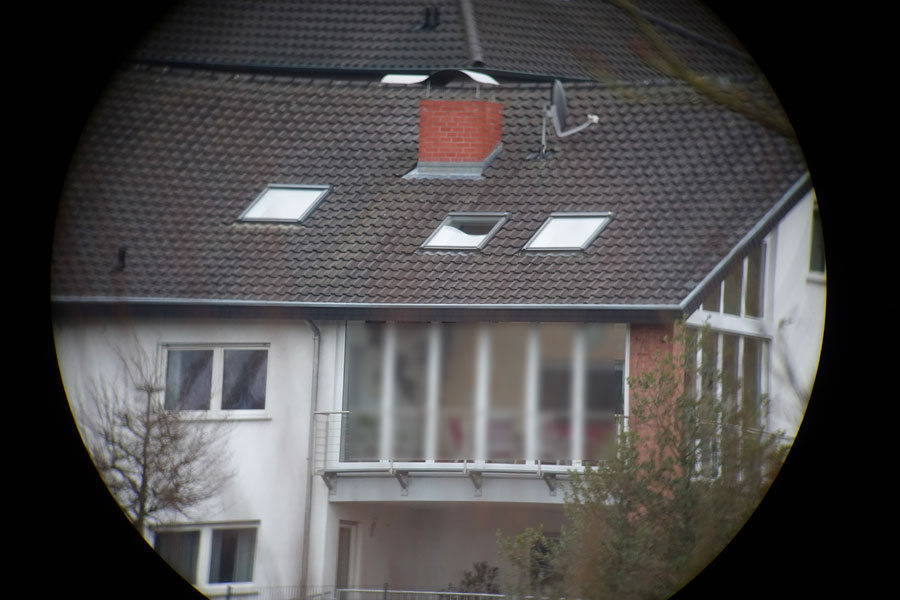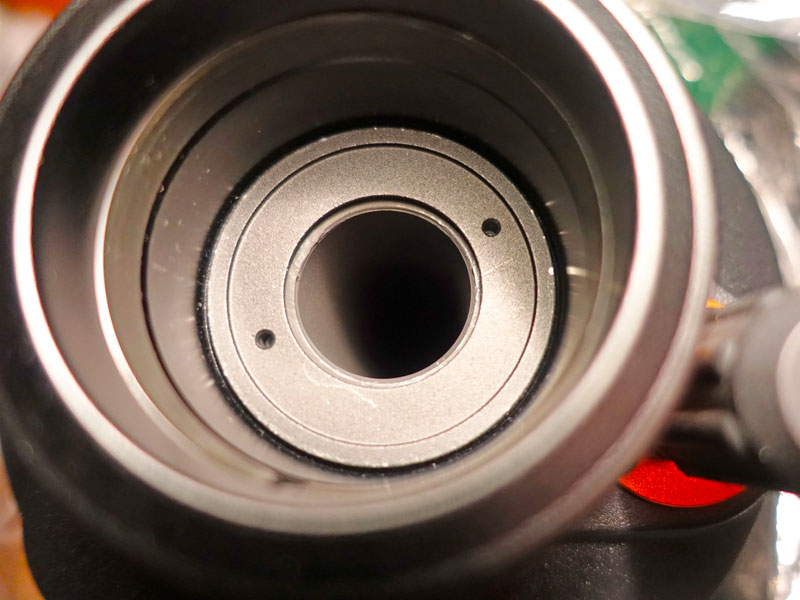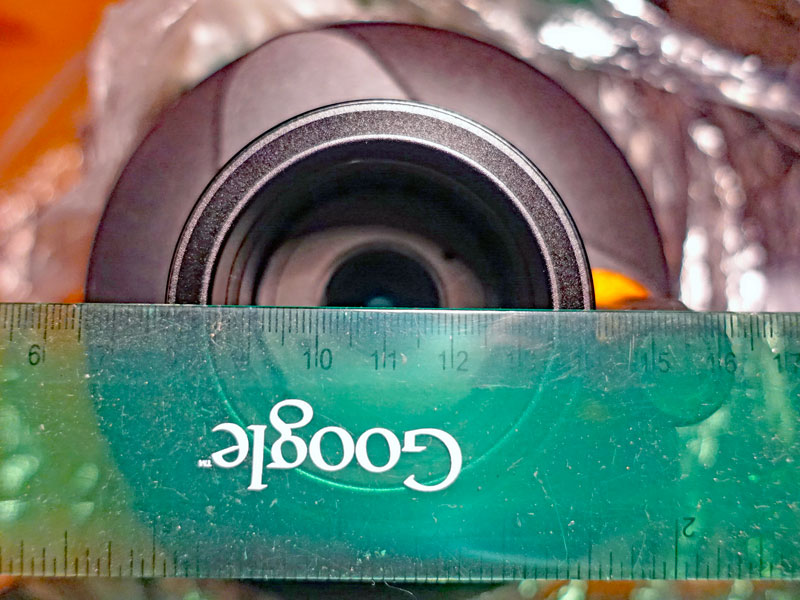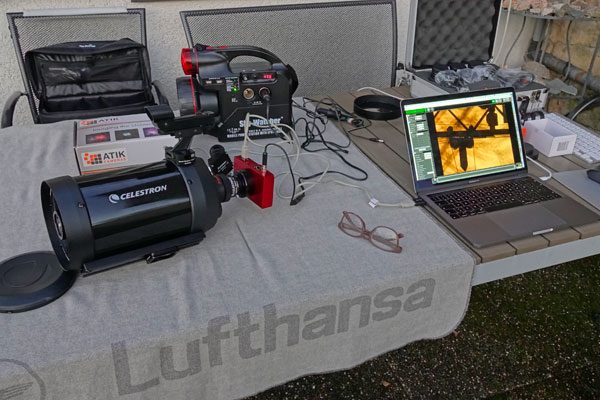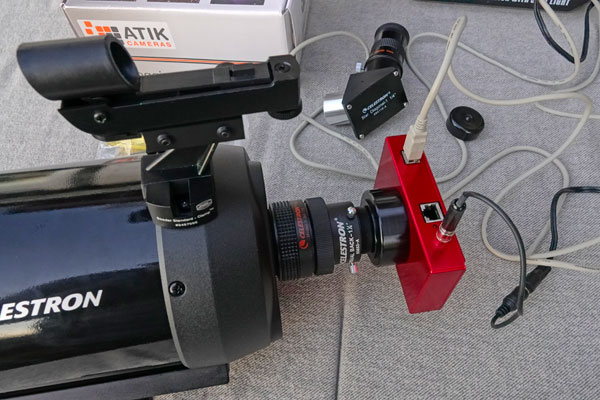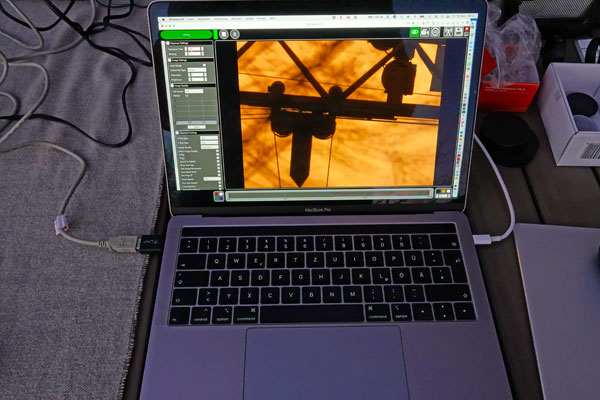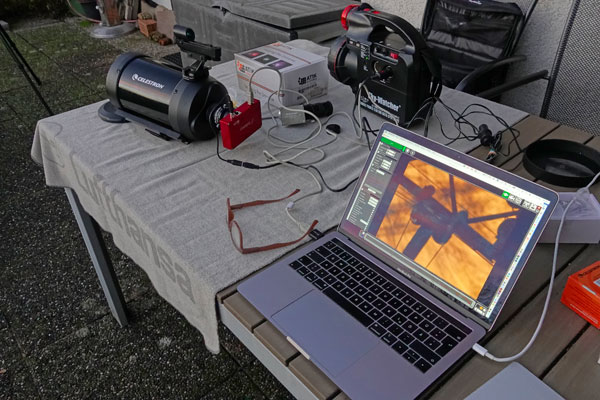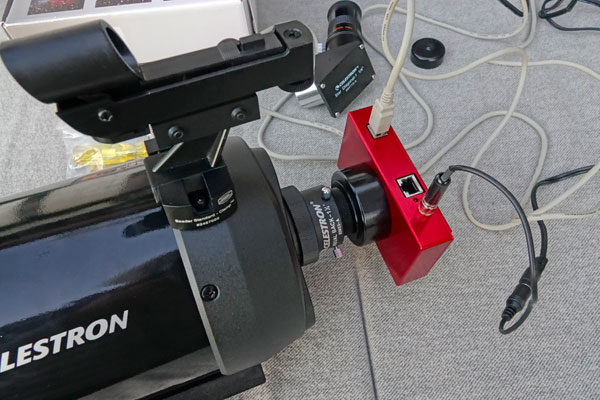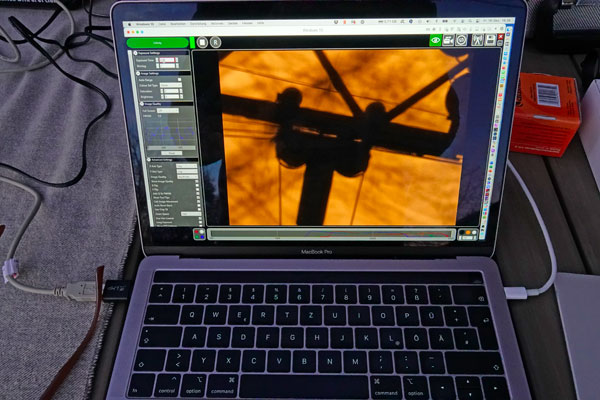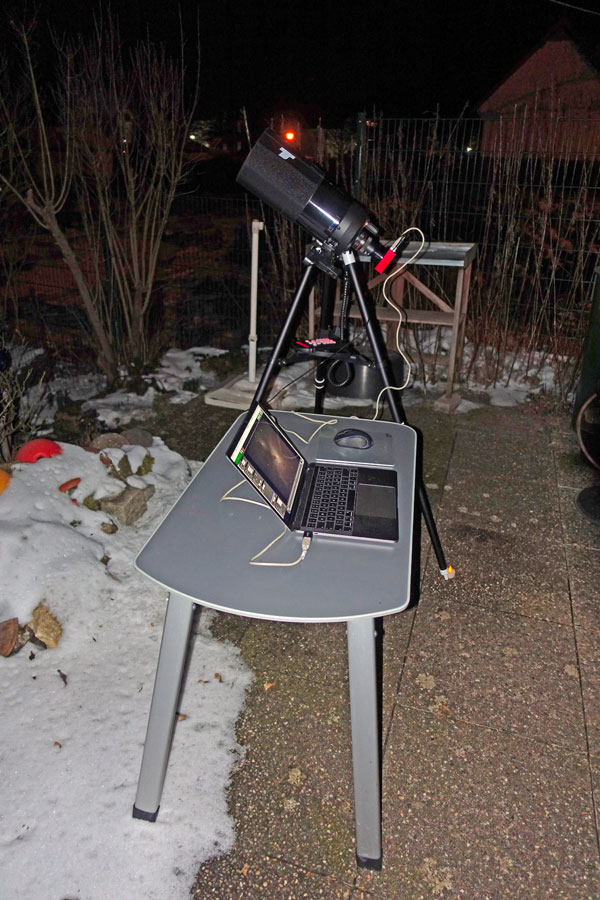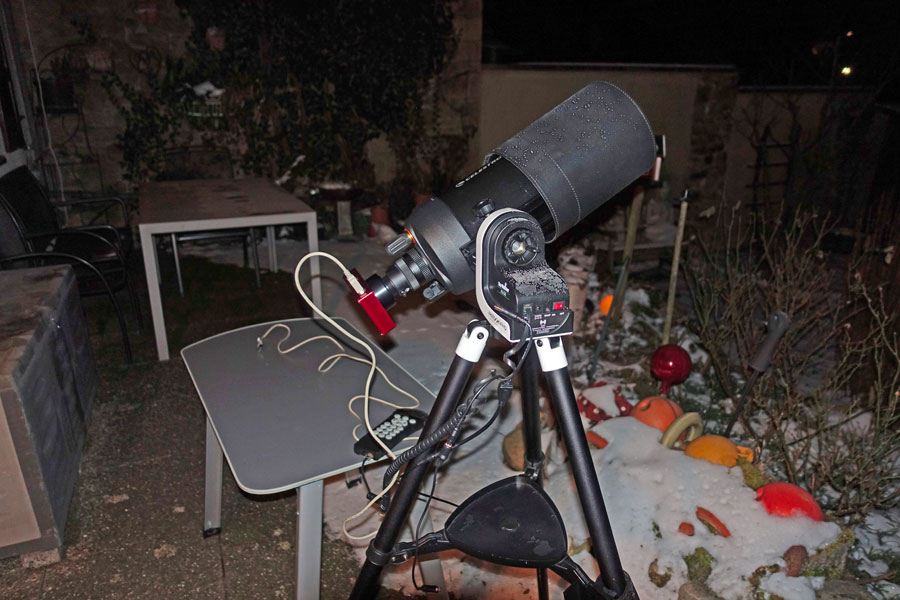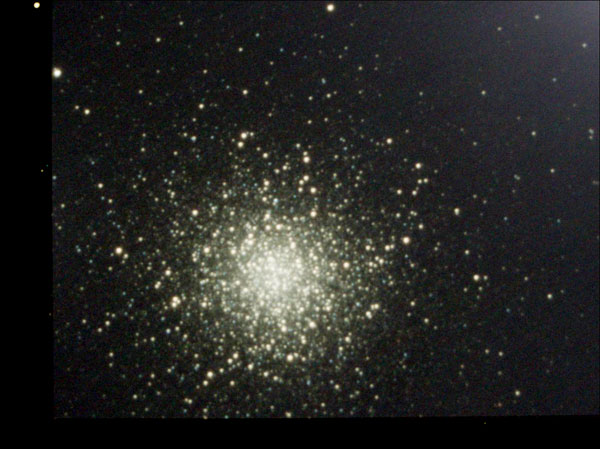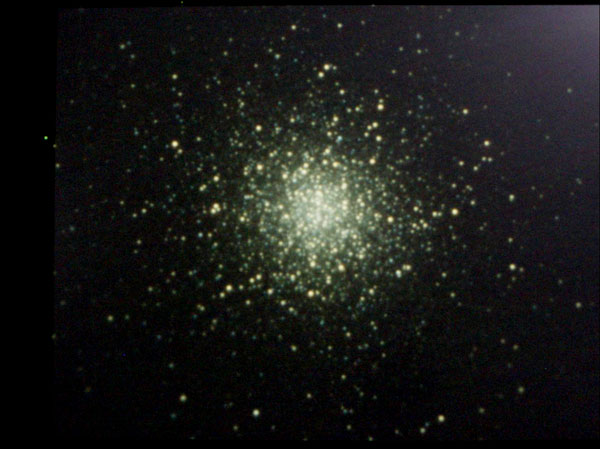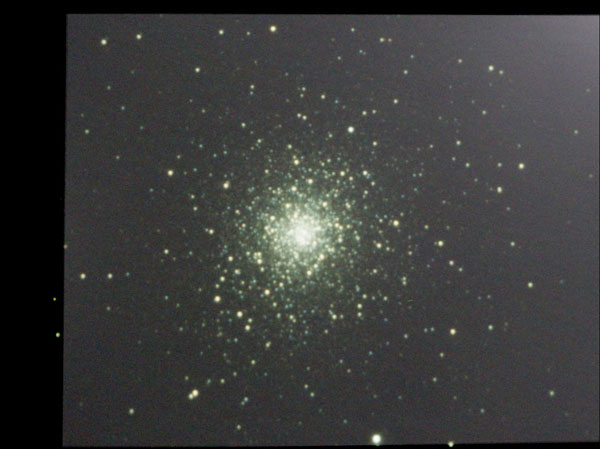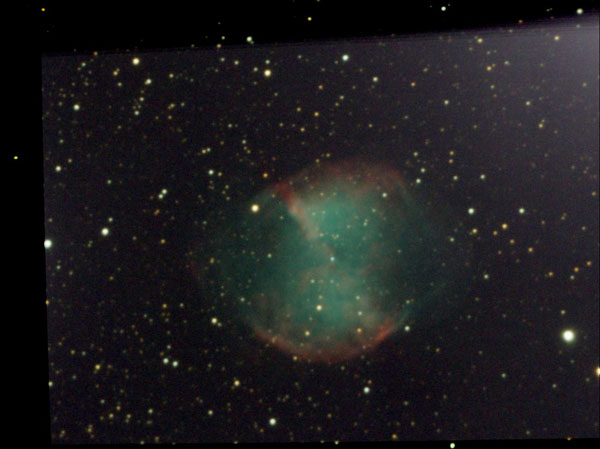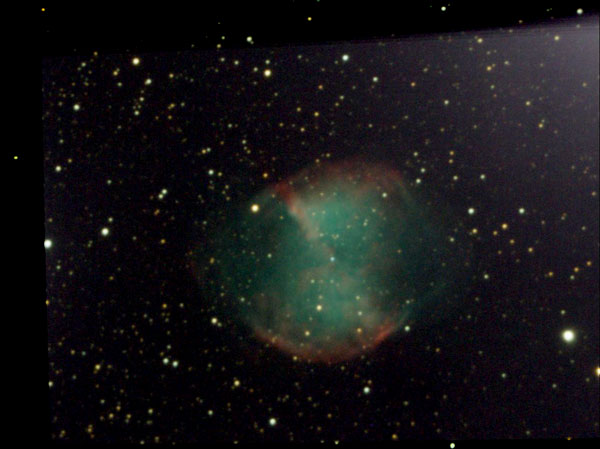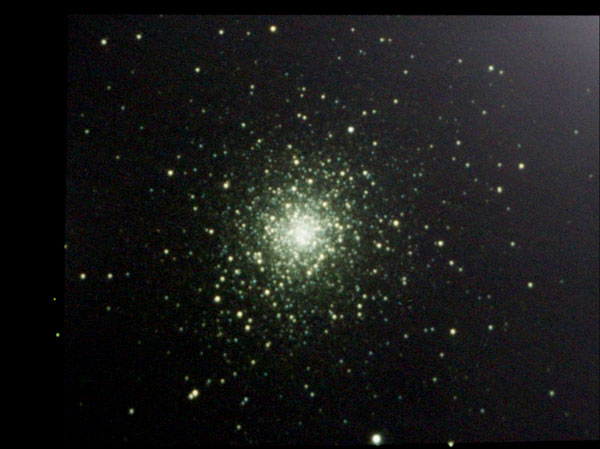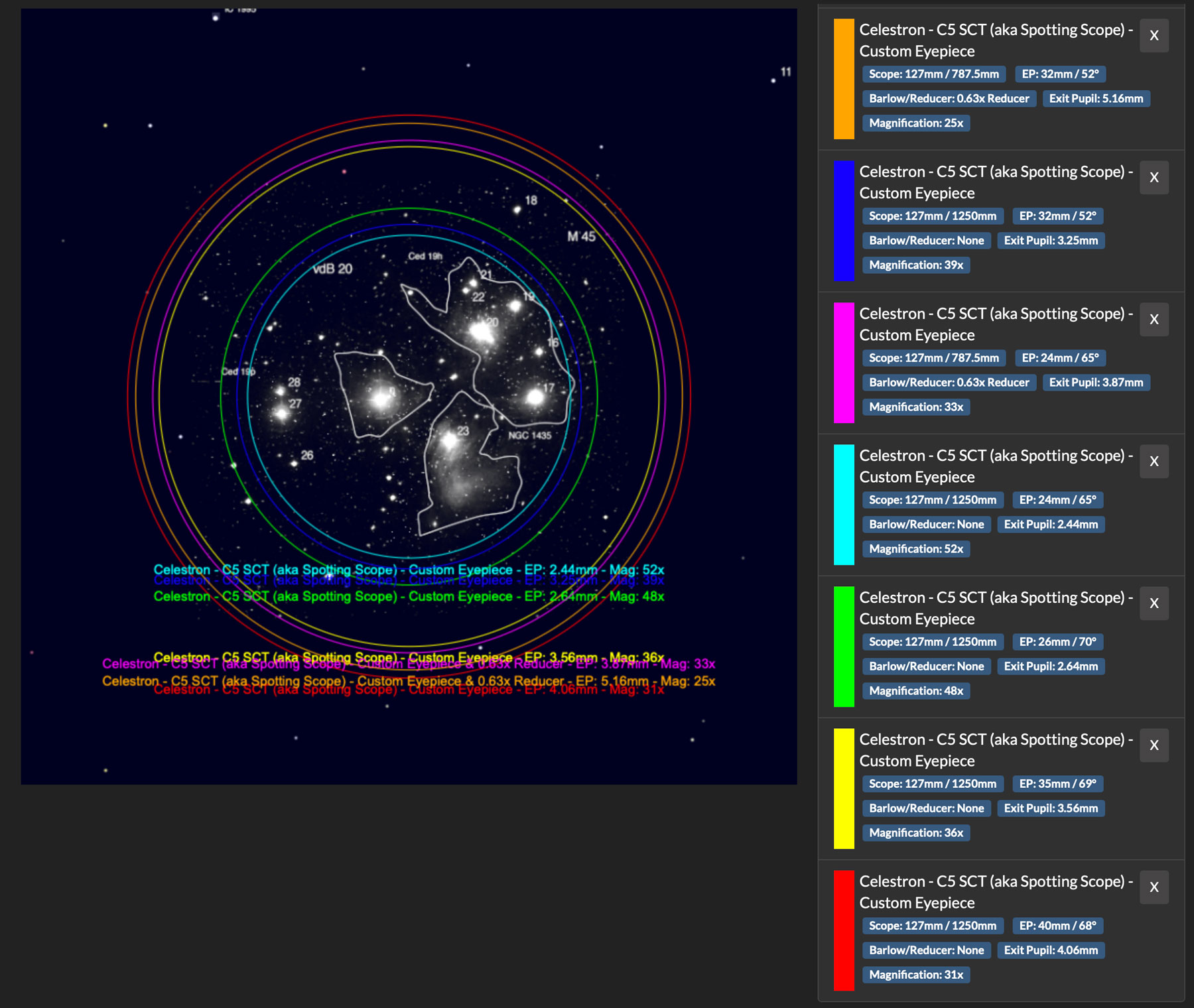Celestron C5 Information (5" Schmidt-Cassegrain)
Motivation | Look | Visited Sky Objects | First Experiences | Further Experiences, Issues, and Modifications | Photo Attempts | First Conclusions | Links | Appendix: FOVSimulations | Appendix 2: Data
On this page I provide some information about the Celestron Schmidt-Cassegrain C5 OTA, which is, however, only marketed as a spotting scope by Celestron (ordered on December 16, 2020; received on December 18, 2020). This telescope is my attempt to acquire a compact, versatile, and comparatively fast travel telescope, which can also be used as a "quick-and-dirty" telescope" and as a spotting scope. I also found out in the meantime that many amateur astronomers consider the C5 as a good solution for EAA (electronically assisted astronomy).
Notes:
- I describe issues and modifications on page C5 - Issues and Modifications.
- For experiences with the f/6.3 reducer/corrector see page C5 - Two Inch Accessories - Yes or No?.
- On page C5 - Travel Packages, I describe how I pacl the C5 for travelling with and without GoTo.
See the appendix for the data.
Motivation
Anyone who read my astronomy history knows that I have quite a lot of "back and forth" behind me when it comes to telescope types and apertures. Actually, only a Schmidt-Cassegrain or pure Cassegrain telescope was missing in my collection. In November 2019, I closed this gap by acquiring a Celestron C8. My motivation behind the C8 purchase was to get more (manageable) aperture (step up from 6" to 8") and simplify my telescope park in one act. Well, the latter goal was only partly achieved... The C5 is now an attempt to acquire a compact, versatile, and comparatively fast travel telescope, which can also be used as a "quick-and-dirty" telescope" and as a spotting scope.
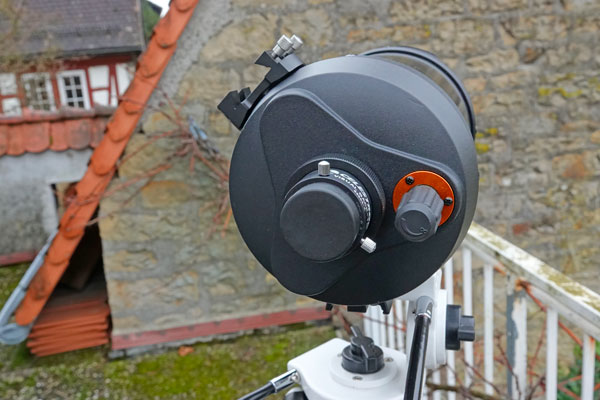 |
||
C5 - side view on the AZ Pronto mount with the original finder and as a spotting scope |
C5 tube, oblique front view |
C5 tube from the rear |
Now I still have a Skymax-127 (Maksutov-Cassegrain) in my "stable". It replaced a Skymax-102, which is even more similar to the C5 in focal length (and also in weight). Why did I decide relatively spontaneously for a C5 as a replacement for this telescope? The deciding factor, after I had come up with the idea, was a very favorable and offer (about 430 versus about 640 EUR). But what do I expect from this telescope? First of all, a better manageability. The C5 is shorter having the same aperture (but more obstruction) and is, above all, much lighter than the Skymax-127. First contacts with the C5 confirm this. And while my AZ Pronto mount is basically already overloaded with the Skymax-127, this is not the case with the C5.
A second consideration is observing flexibility. With the Skymax-127,
the smallest magnification is about 60 x,which corresponds to a FOV
of just over 1.1°. This is a bit too narrow for many DSO applications.
With the C5, this is also only 50 x and about 1.3° FOV, but in conjunction
with the f/6.3 reducer/corrector, I get a a little more than a magnification
of 30 x and an angle of view of almost 2°. With this FOV, one can already
see the Pleiades M 45 well! In other words, with the corrector, I can extend
the range of use of the C5, so that it is almost a universal telescope. Basically,
it is, at least on paper, even sufficient to observe just with the reducer/corrector,
as long as I do not want to go beyond a magnification of 200 x (which is what
I can achieve with my existing eyepieces (4 mm...24/32 mm).
Note: In the meantime, I found a solution to operate the Skymax-127 also with 2" accessories and to use the f/6.3 reducer/corrector on it. Thus, it has caught up with the C5 again!
The real and critical question now is: Can the C5 keep up with the Skymax-127 in image quality or is it even a tad better? Discussions on the Internet unfortunately only give "mixed" results...
Look
Unboxing
|
Amazon outer box |
Ditto |
Ditto, opened |
|
Celestron outer box |
Ditto |
Ditto |
|
Amazon box in the back, Celestron outer box opened |
Celestron outer box opened |
All the three boxes... |
|
Celestron inner box opened, telescope bag visible |
Telescope bag taken out of the box |
The box content: Telescope bag with tube and accessories inside |
|
Telescope bag opened, telescope tube visible |
Telescope bag opened, telescope tube and accessories visible |
Telescope tube and accessories taken out of the bag |
|
Empty telescope bag |
Telescope tube and accessories taken out of the bag |
Ditto, closer view |
|
Ditto, different view |
Ditto, accessories taken out of their boxes |
Ditto, closer view |
Sizes and weights:
- Amazon outer box: 50,8 x 40,0 x 30,0 cm (WDH, according to label)
- Celestron outer box: 43 x 36 x 28 cm (WDH, my own measurement)
- Celestron inner box: 41 x 33 x 25 cm (WDH, my own measurement)
- Complete weight (with Amazon box): 6.1 kg (according to label)
- Celestron outer box: 5 kg gross, 2.9 kg net (according to label)
- Tube weight with lids, visual back, Baader finder shoe: 2.33 kg (my own measurement, perhaps a little)
C5 on AZ Pronto Mount
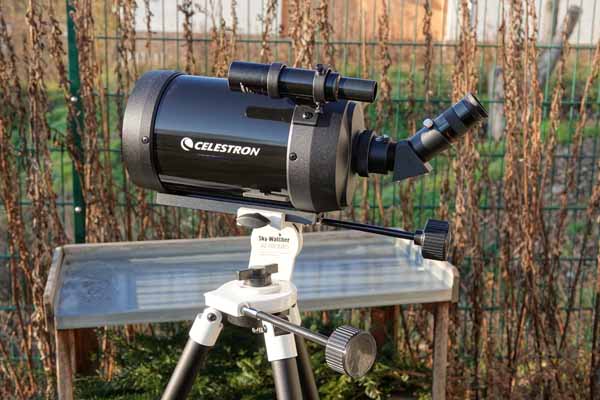 |
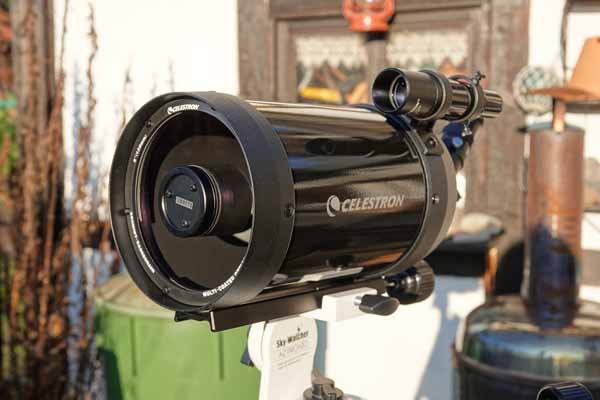 |
|
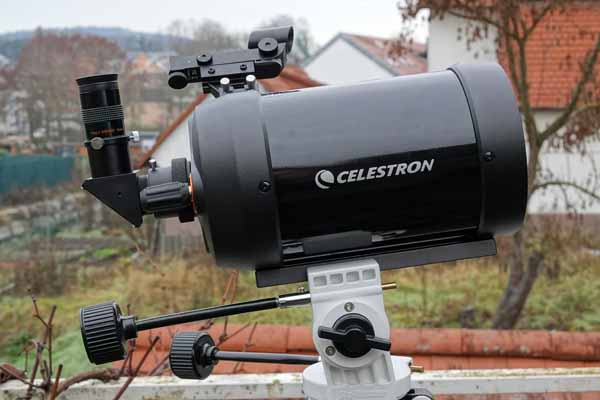 |
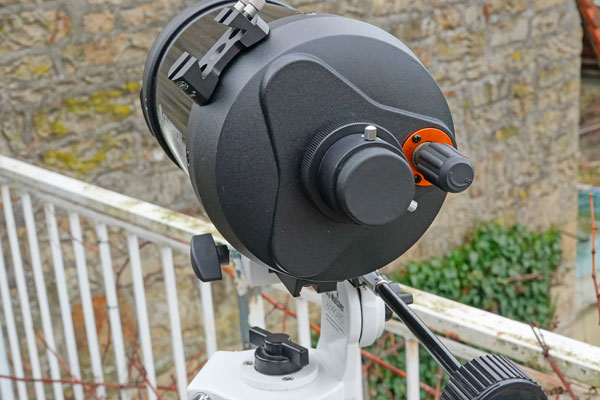 |
 |
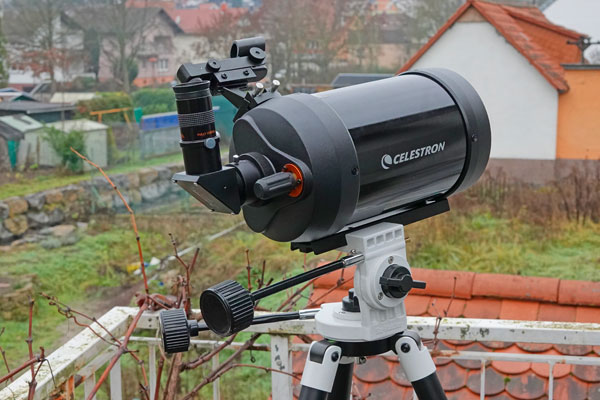 |
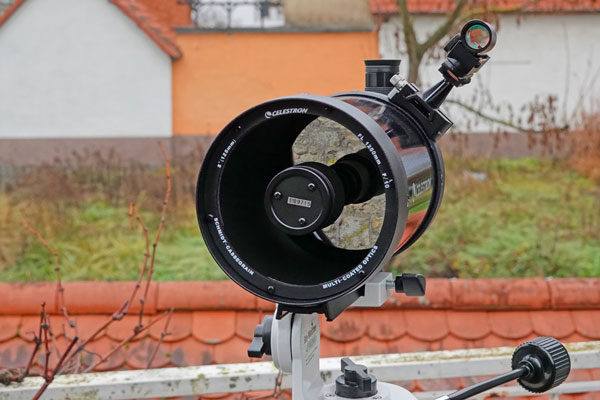 |
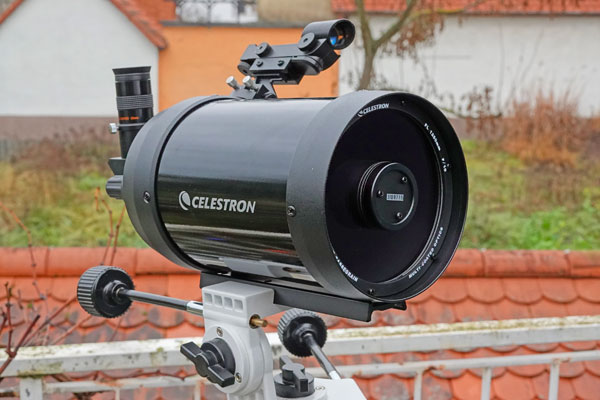 |
C5 on Photo Tripod
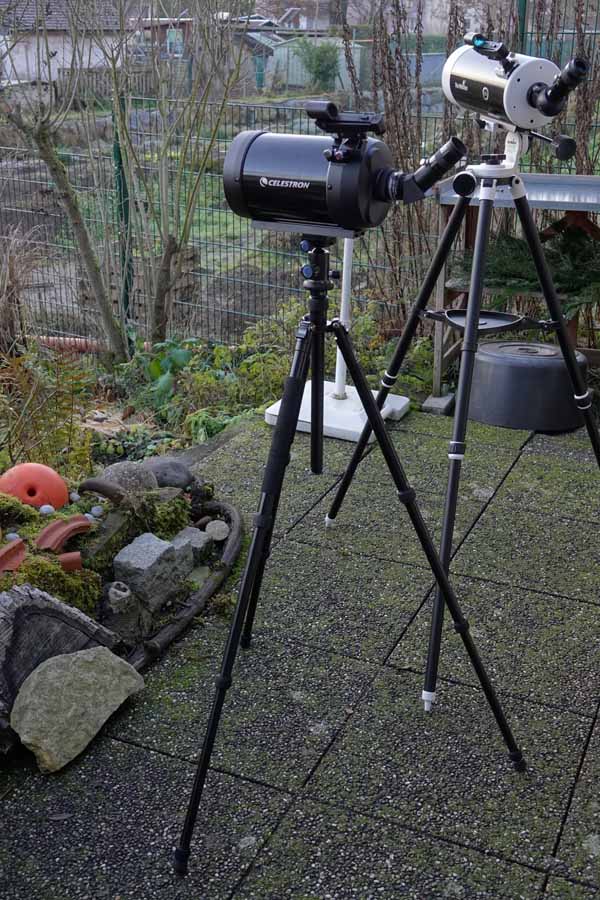 |
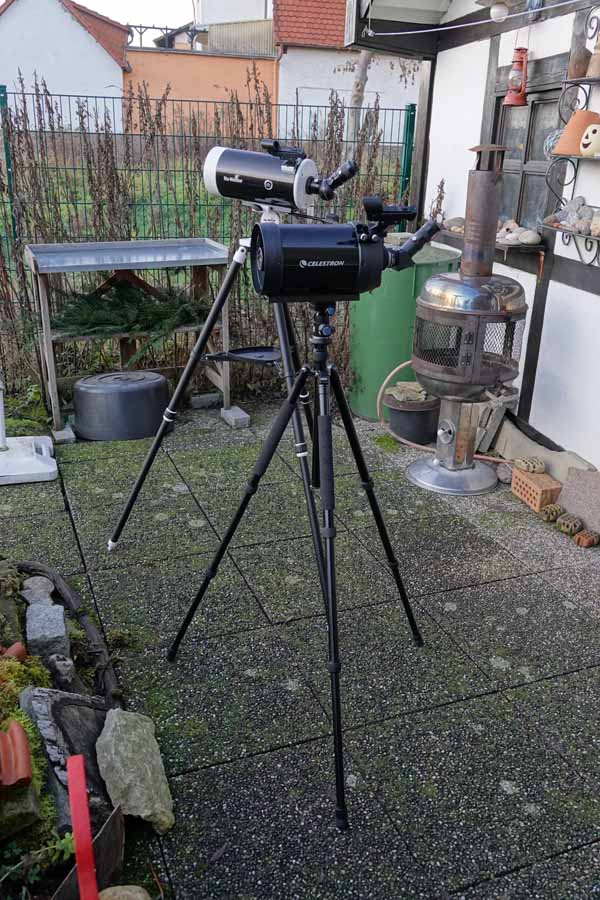 |
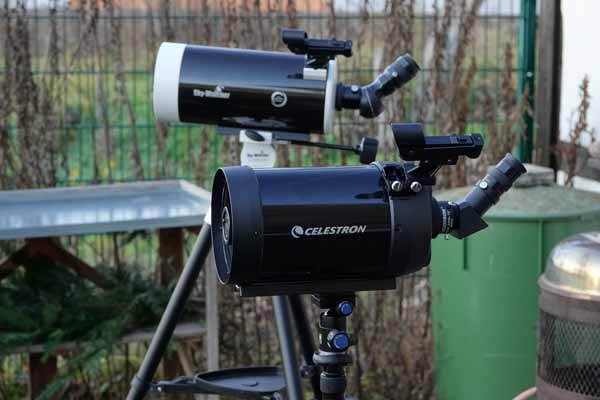 |
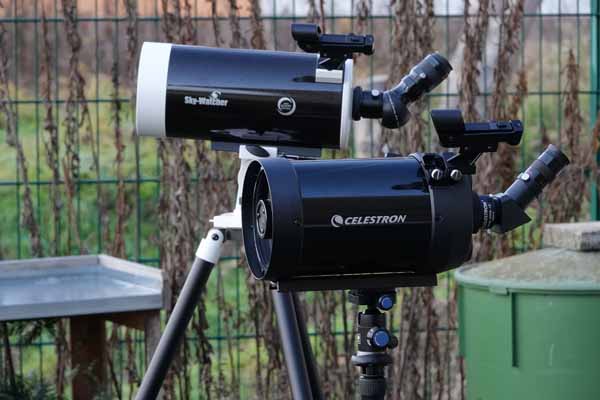 |
C5 on AZ-GTi GoTo Mount
C5 on AZ-GTi mount
with extension tube |
||
Ditto |
Zenith position
without any problems... |
|
|
Without extension tube |
Without
the extension tube, the C5 does not touch the tripod legs in the zenith
position |
|
Red-Dot Finder, Eyepieces, Zenith Mirrors, and Amici Prisms...
|
C5 tube with original finder and finder shoe
|
New Baader finder shoe |
Red-dot finder in the new finder shoe |
|
Original cap for the 1,25" connection |
Alternative cap for the 1,25" connection (easier to remove, but does not protect the thread) |
Original Celestron 25 mm Plössl eyepiece and Celestron zenith mirror |
|
Original Celestron 25 mm Plössl eyepiece and Celestron zenith mirror (with reducer/corrector) |
24 mm Televue wide angle eyepiece (with reducer/corrector) |
32 mm Digiscope eyepiece (with reducer/corrector) |
|
Original Celestron 25 mm Plössl eyepiece and Celestron zenith mirror (with reducer/corrector) |
24 mm Televue wide angle eyepiece |
32 mm Digiscope eyepiece |
|
Celestron 25 mm Plössl eyepiece and Celestron Amici prism |
Celestron 25 mm Plössl eyepiece and Baader Amici prism |
Celestron 25 mm Plössl eyepiece and Lacerta zenith mirror |
|
Celestron 25 mm Plössl- eyepiece and Celestron Amici prism (with reducer/corrector) |
Celestron 25 mm Plössl eyepiece and Baader Amici prism (with reducer/corrector) |
Celestron 25 mm Plössl eyepiece and Lacerta zenith mirror (with reducer/corrector) |
Dew Cap
|
Dew cap in its foil |
Ditto |
Dew cap does not lie flat, because of the packaging |
|
Dew cap flat, outer side |
Dew cap flat, inner side |
Dew cap put on; there is no recess for the prism rail |
|
Dew cap put front view |
Ditto, closer view; you can see the felt inside |
Dew cap put on; there is no recess for the prism rail |
Bag
|
Bag |
Bag with C5 opened (original state) |
Bag empty (original state) |
Comparison with Sky-Watcher Skymax-127 and Celestron C8
Bags (full)
|
C8 in blue bag |
Skymax-127 in the black bag in front |
C5 in the black bag in the middle |
Comparison of the Tubes
Comparison with Sky-Watcher Skymax-127
 |
||
Comparison with Celestron C8
Comparison with Celestron C8 and Sky-Watcher Skymax-127
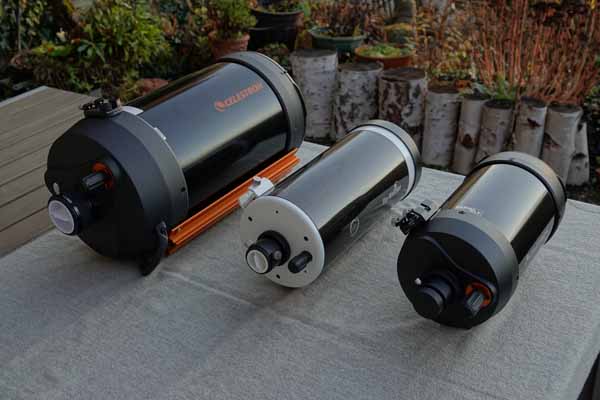 |
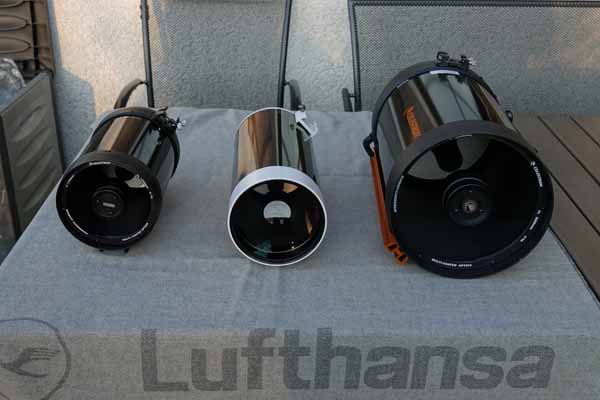 |
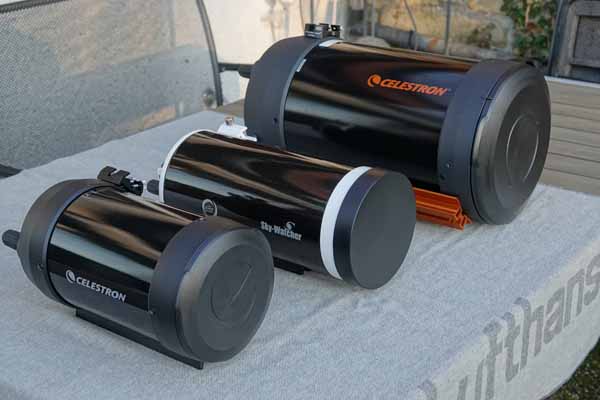 |
Visited Sky Objects
So far, I have visited the following sky objects with the Celestron C5:
- Moon (crescent, half)
- Mars, Jupiter and Saturn after conjunction
- Cr 399, M 11, M 13, M 15, M 27, M 35, M 36, M 37, M 38, M 42/43, M 45, M 50, M 57, M 78, Mel 25, NGC 884/869
- Albireo
- C/2023 A3 (Tsuchinshan-ATLAS)
- Atik Infinity: M 35, M 42/43, M 45, M 78, M 105 mit den Galaxien NGC 3384 (elliptisch) und der kleineren NGC 3389 (Spirale)
- ZWO ASI224: M 13, M 27, M 51, M 92, Jupiter, Saturn
First Experiences
Very First Impressions...
I present my preliminary considerations for the purchase of the C5 in section "Motivation" and do not want to repeat these here.
Size and Weight
The Celestron C5 appeared to me from the beginning as a small "dinky" telescope. In photo comparison with the Skymax-127 (which has the same aperture), it seems thicker in the front and back, but it is slightly shorter. The biggest difference between both tubes is the weight, nominally 2.7 kg for the C5 against 3.4 kg for the Skymax. I measured myself even only about 2.3 kg for the C5 (with lids, 1.25" visual back and Baader finder shoe), but this need not be true. All in all, the C5 seems much more manageable than the Skymax-127, which seems really heavy to me - and which is supposed to be replaced by the C5. But of course, the C5 must also convince me with its image quality - and that is still pending.
Finder and Finder Shoe
The C5 OTA is sold as a spotting scope and as such comes with an erecting finder scope. Maybe an erecting finder is not bad at all at night - in this respect it resembles a red-dot finder. However, because I generally prefer a red-dot finder and also do not get along with three-screw mounts, I removed the original finder shoe and installed a "classic" finder shoe in first place.
|
C5 - side view on the AZ Pronto mount with the original finder and as a spotting scope |
C5 tube, oblique front view |
The original finder holder with three fastening screws made of plastic |
|
The TS-Optics finder shoe that I was not able to install properly |
Baader finder shoe installed properly |
Red-dot finder in the new finder shoe |
At first, I had tried to install an existing "long hole" finder shoe from TS-Optics. Because this did not succeed, I "borrowed" a Baader finder shoe from the C8 and was able to install it without any problems. I describe my efforts on page C5 - Issues and Modifications.
Bag
|
Bag |
Bag with C5 opened (original state) |
Bag empty (original state) |
The bag is light and handy, but ultimately cheaply made. It is only designed to hold the original accessories of the spotting scope. In order to be able to transport additional or other parts in the bag, you first have to "dig" holes into the Styrofoam, which is a bit tedious. This inflexibility of the bag has also been criticized by other owners.
Used as a Spotting Scope (Comparison with Skymax-127)
On December 21, 2020, I mounted the C5 on my photo tripod and the Skymax-127 on the AZ Pronto to make a first comparison when using both as a spotting scope. The Skymax-127 magnifies a little more, otherwise I did not see much difference between the two scopes. Perhaps, the image was slightly clearer in the C5 at times. I observed two cats, and both scopes showed nice details (hair, whiskers, eyes). In any case, this comparison did not indicate that I necessarily need to keep the Skymax-127 because it is so much better than the C5. With 24 mm and 25 mm eyepiece focal lengths, respectively, I got magnifications of a little more than 60 x and a little more than 50 x, which is already too much in many cases. With the 32 mm and the reducer/corrector on the C5, I get down to just under 25 x, which is sufficient for many applications.
During this test, I noticed that my 24 mm Televue wide-angle eyepiece (65°) vignetted on the Celestron Amici prism, but not on the Baader Amici prism. Other wide-angle eyepieces did, however, not vignette on the Celestron Amici prism.
2" Accessories and Baader ClickLock
In astronomy forums I came across discussions in which the question was raised, whether 2" accessories can be meaningfully used on the C5. In the end, I have not been able to find a clear answer, actually it is "no". Despite this answer, some posters have decided to buy 2" accessories. So I thought I would give it a try myself, since I have 2" accessories available from the C8 (and from the refractors). However, I failed after only a few turns: the Baader ClickLock adapter cannot be screwed onto the SC thread on the tube, because the locking lever of the adapter bumps against the focusing knob of the C5.
I made a second attempt on this, after I had removed the locking lever. Read more on this on page C5 - Issues and Modifications. After this attempt, I decided to purchase another ClickLock adapter for the C5. In the meantime, it arrived, and I installed it:
|
ClickLock open (locking lever screwed on again) |
ClickLock "locked" |
40 mm eyepiece (2") |
Now It's Time for "Tests"!
For space reasons, I moved the results of my practical daylight tests of 2" eyepieces to page C5 - Two Inch Accessories - Yes or No?. Below, I demonstrate the most important results.
Vignetting with 2" Eyepieces? (January 18, 2021)
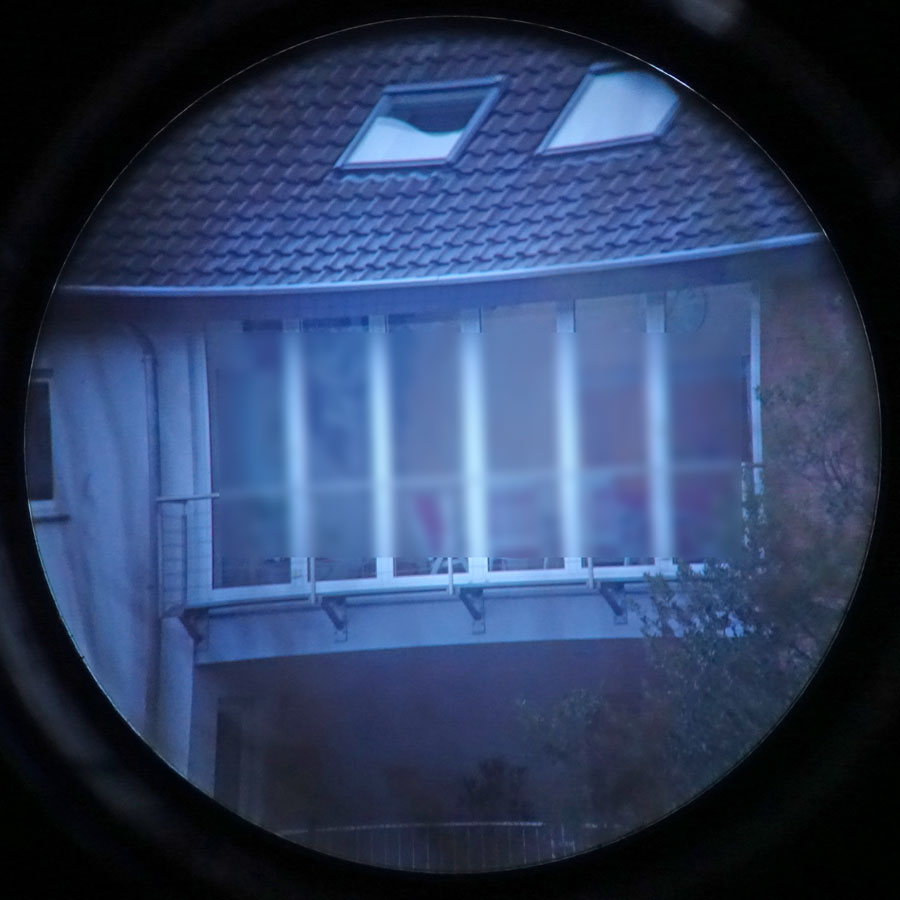 |
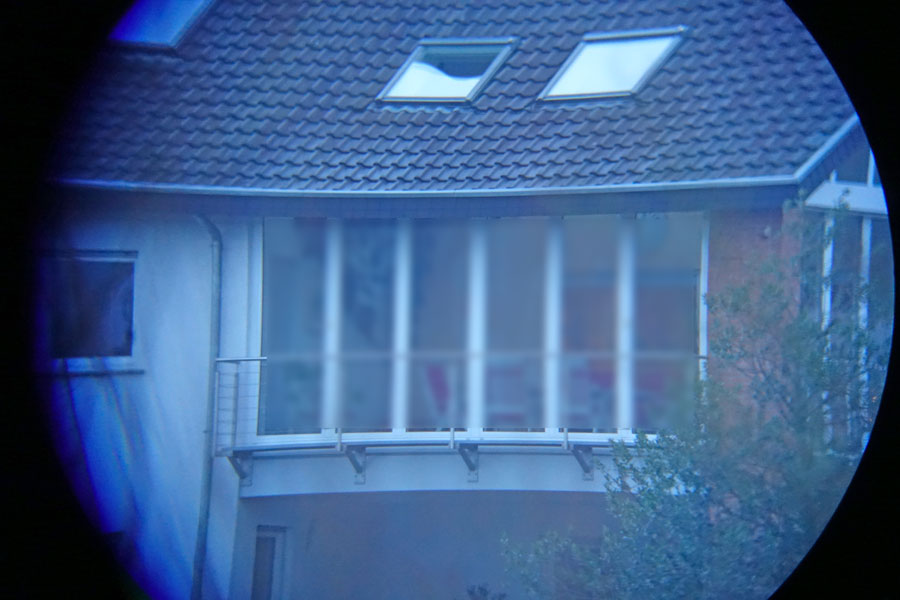 |
|
32 mm Digiscope eyepiece (Plössl, 1,25" > 1.33°) |
26 mm eyepiece (2", 70° > 1.46°) |
|
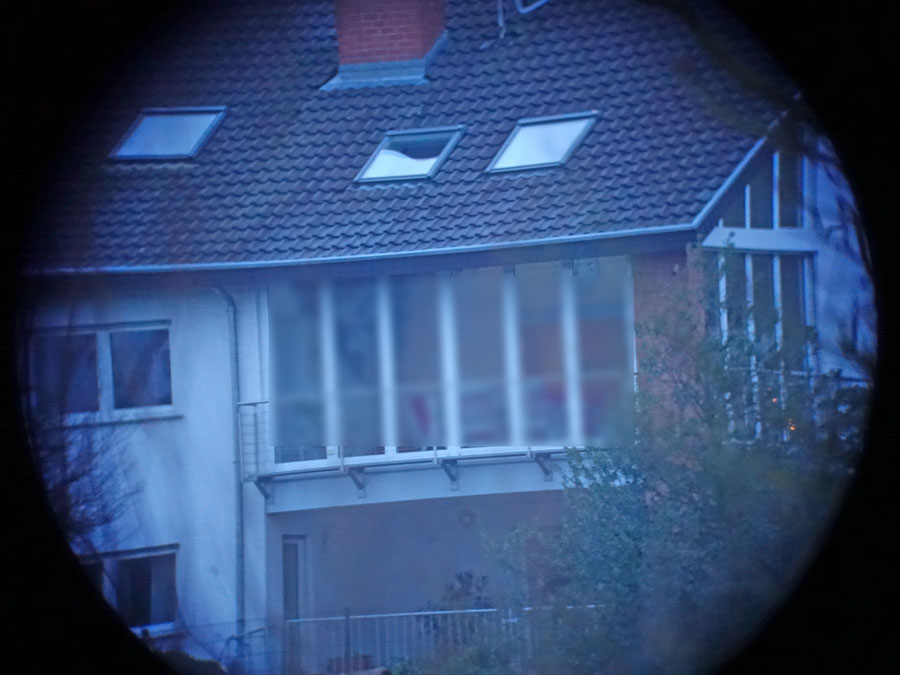 |
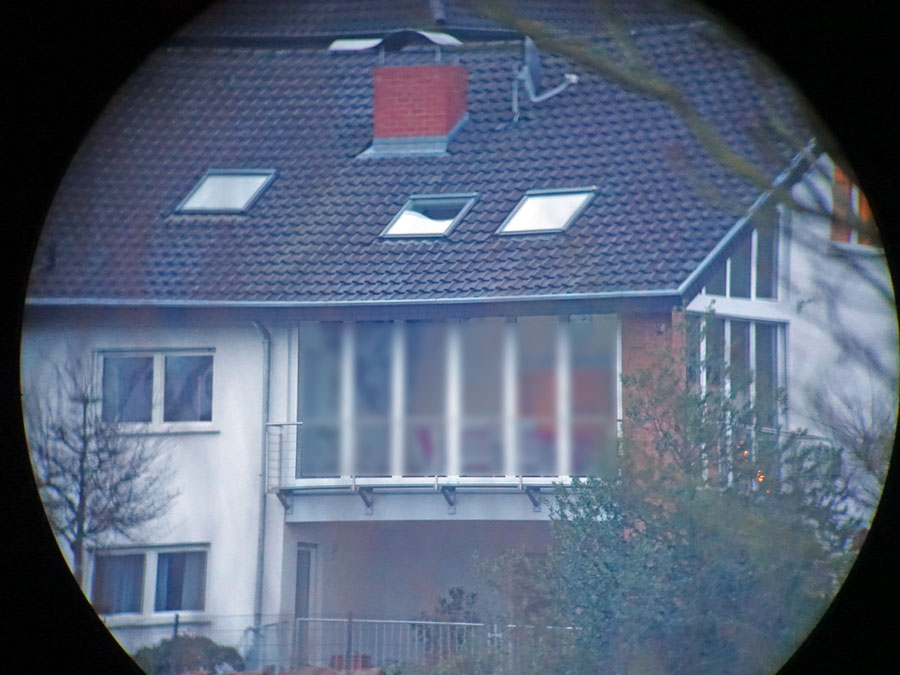 |
|
35 mm eyepiece (2", 69 ° > 1.93° ) |
40 mm eyepiece (2", 68° > 2.18°) |
Field of View Comparison (January 19, 2021)
Very First Impressions at the Sky
"First Light"...
My "first light" with the C5 on 12/18/2020 was unfortunately somewhat limited. First, I compared the C5 with the Skymax-127 at the crescent moon. I was surprised about the difference in image size of when using similar eyepieces. The image in the Skymax-127 is larger than in the C5 because of the focal length difference of 1500 mm to 1250 mm (the C5's image size corresponds approximately to that of the Skymax-102), but I had not expected the difference to be so large. Later, I realized that I had left the f/6.3 reducer/corrector at the C5 tube, which I had previously used for testing the Atik Infinity camera at the C5. Oh well...
Overall, the image seemed nicer in the C5 to my wife, while I was not quite sure myself. When using a 16 mm eyepiece, the image in the C5 already seemed noticeably darker to me, but I did not make a comparison with the Skymax-127, because I do not own a comparable eyepiece...
When it became darker, I visited some DSO with the C5. There were not many, because I had trouble finding some objects by hand. M 15 in Pegasus was quite faint, no comparison with what the C8 showed some days before; that was probably without reducer/corrector. M 45 was nice with the reducer/corrector, as was the Perseus double cluster NGC 884/869. I also wandered a little around the sky with the reducer/corrector. All in all, these observations were, of course, not really meaningful...
A Quick Comparison at the Orion Nebula (End of December 2020)
On December 28, 2020, I did a quick comparison with four of my telescopes using the Orion Nebula M 42/43, which the TLAPO1027 clearly won (nearly full moon, moon close to Orion). The order was: PS 72/432 < C5 < Skymax-127 < TLAPO1027.
A First Test at Night with 2" Accessories (January 2021)
On January 10, 2021, I tested the C5 for the first time with 2" accessories at night (M 42/43, M 45, M 35, M 37). I was not able to see any vignetting with the 26 mm and 40 mm eyepieces. However, I had certain problems with looking through the 40 mm eyepiece (obviously, the kidney bean effect - i was too close to the eyepiece). All in all, this evening confirmed that 2" accessories can be used at the C5 at night.
First Impressions - A First more Extended Program...
On February 13, 2021, I operated the C5 for the first time with a "more extended" program and afterwards even photographed with the Atik Infinity and the C5 (see further below). It was two days after new moon, and the moon crescent was just visible (the ash gray region was visible, as well). So the sky was still quite dark. I observed starting at about 7 p.m. with the C5 on the AZ-GTi mount using the handbox (2-star alignment on Rigel and Castor) and using an f/6.3-reducer/corrector and a 24 mm eyepiece. The GoTo aligment was always a little "off", that is, the object eas too far to the left in the field of view, but just visible in the eyepiece. I accessed the following targets:
- M 42: several times, got better and better
- M 45: saw only part of it
- M 35, M 36, M 37 (compact), M 38
- M 78: very faint
- NGC 2044 not accepted by ther mount; accessed Alnitak instead, but there was nothing to see... I was in error initially, it was NGC 2024!!!! But there was also nothing to see...
- M 1: nothing to see
- M 50: still obscured... Found it later (see below).
During a meal break, I tested the automatic tracking on M 42/43. After a quarter of an hour M 42/43 was lost in the eyepiece, but could be "caught" again with a GoTo command (after that, it was nearly centered). I wonder, whether used a wrong tracking mode or tracking was not set....
After the break, I found M 50 only with some effort. Since I could not find M 50 at first, I tested on Sirius how large the deviation of the mount was. I corrected this at M 50 accordingly and thus, found M 50... Afterwards, I photographed with the Atik Infinity - see below!
Further Experiences, Issues, and Modifications
I will report further experiences with the Celestron C5 on a new page, because this page has already become far too long. The same applies to issues and modifications that I describe on page C5 - Issues and Modifications. Page C5 - Two Inch Accessories - Yes or No? covers the topic of using 2" accessories versus 1.25" accessories plus the Celestron reducer/corrector.
Diameter of the Rear Baffle
In the Cloudy Nights thread Rear Opening Sizes of Celestron SCT OTAs, I found the following values for the rear baffles of the Celestron tubes:
- C5: 25 mm
- C6: 27 mm (elsewhere*, I found the values 26 mm, 25 mm, and "like the C5")
- C8 38 mm
- C9.25: 45 mm or 48mm
- C11: 54 mm
- C14: 54 mm
*) How to calculate Maximum Field of View in c6 SCT (please scroll through the thread)
I therefore looked into the back of the C5 myself (January 20, 2021) and tried to measure the diameter of the port (a long thin tube called rear baffle...) - and can confirm a diameter of 25 mm.
Photo Attempts
Dry Run with Atik Infinity
In a dry run (18.12.2020), I tested whether the Atik Infinity can be operated with and without reducer/corrector at the C5. This was indeed the case as the following photos show:
|
C5 with 1.25" visual back and f/6.3 reducer/corrector |
Ditto |
Result |
|
C5 with 1.25" visual back |
Ditto |
Photos with the Atik Affinity (First Test at Night)
Note: These night test appears in more detail on page Atik Infinity - Further Experiences (Nightly Tests). More results will be presented elsewhere on this Website.
On February 13, 2021, I made a first "night test" with the Atik Infinity camera at the Celestron C5. I used the following configuration: C5 with f/6.3 reducer/corrector and 1.25" visual back on the AZ-GTi mount, which I operated with the handbox. I performed a 2-star alignment.
I observed M 35, M 42/43 (Orion Nebula), M 45 (Pleiades), M 78, and once more M 42/43. Here are some of the photos that I took during this session:
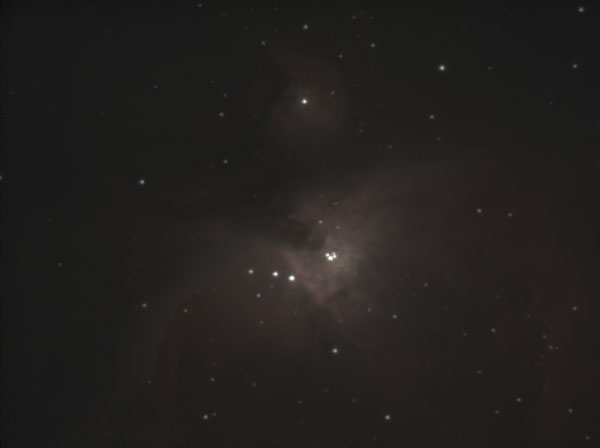 |
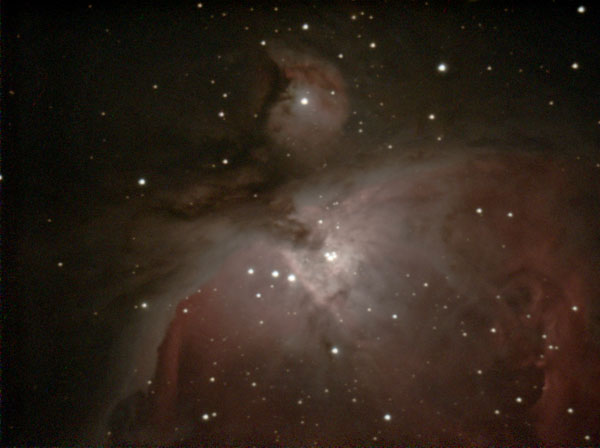 |
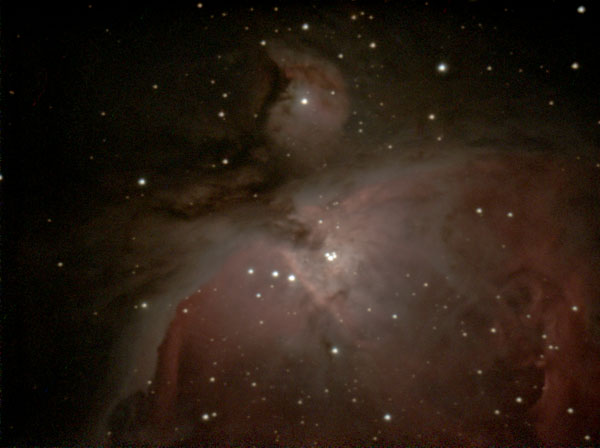 |
||
M 42/43 (Orion) |
Ditto, post-processed |
Ditto, alternatively post-processed |
||
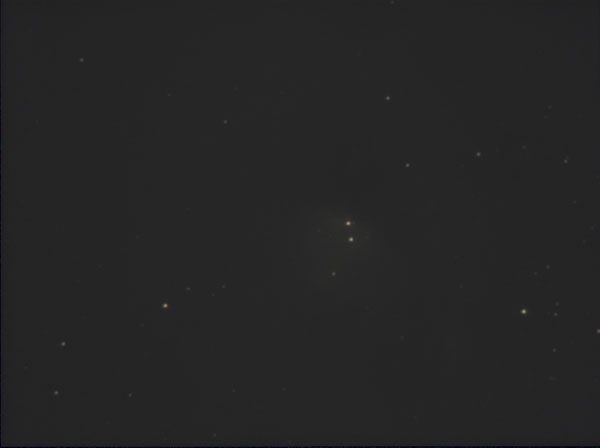 |
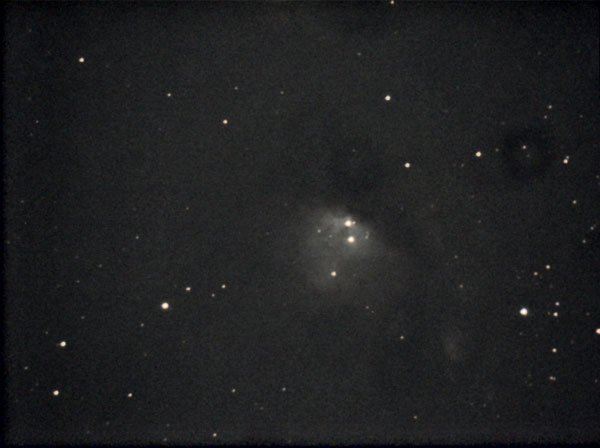 |
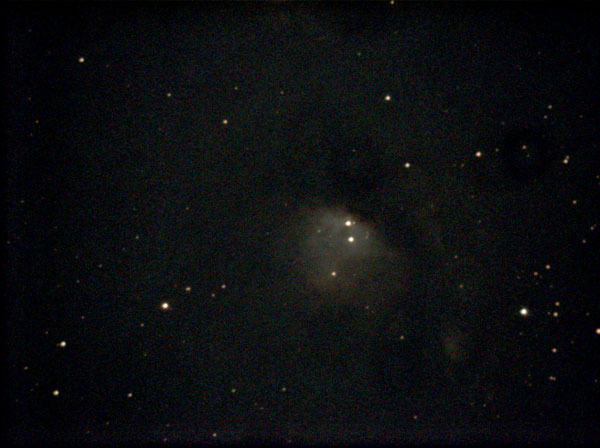 |
||
M 78 (Orion) |
Ditto, post-processed |
Ditto, alternatively post-processed |
All in all, I found the achieved results, except for those for M 42/43 and M 78, fairly disappointing. In the end, the dew cap and the mount were a little icy:
|
C5 with 1,25" visual back and f/6.3 reducer/corrector on AZ-GTi mount |
September 3, 2021: A Night Test with the ZWO ASI224
Note: This night test is presented in more detail on page ZWO ASI224 Color Camera - Further Experiences.
C5 on AZ-GTi with ASI224MC, later also with UV/IR Cut Filter; photos:
First Conclusions
It is far too early for any first conclusions, but perhaps a few thought are in place after my first experiences with the C5...
The C5 is definitely a handy telescope, much more handy for me than the Skymax-127 because of its lower weight. With the f/6.3 reducer/corrector, it covers a magnification range between 25 x and 200 x with my existing eyepieces (2° to 0.4°FOV), making it quite universal and more flexible than the Skymax-127 without such a reducer.
It looks as if 2" accessories can be used at the C5, although it was not designed for this. See page C5 - Two Inch Accessories - Yes or No? for details. First tests with 2" accessories in daylight and at night gave mostly positive results. You will, however, not achieve a larger field of view this way! Using the f/6.3 reducer/corrector with the "maximum" focal lengths for 1.25" is more or less equivalent to using 2" maximum focal lengths without the reducer/corrector (meanwhile, I am also able to connect 2" accessories to the Skymax-127).
The ultimate question remains about the image quality and how the C5 fares in comparison with the Skymax-127. Since I sold the Skymax-127 soon after I had bought the C5, the comparison question can no longer be ultimately answered. Luckily, I think...
Updates: So I thought... However, I bought the Skymax-127 back the same year. Luckily, I store it in our vacation home, so comparisons would be hard to do...
At the end of 2024, I sold my Skymax-127 again...
In the CloudyNights EAA forum, I found that the C5 is considered as an "ideal choice" for EAA by some hobby astronomers, at least, as long as it has to be compact and inexpensive. In this respect, I decided "intuitively" right (or not too wrong...) with the C5 and the AZ-GTi mount with wedge. I made first attempts with the Atik Infinity and the ZWO ASI224MC in AZ mode, and at least, it worked. There were, however, some problems with the GoTo accuracy and the software of the Atik Infinity camera. Overall, the photos also turned out too dark with the Atik Infinity, a problem that I had with this camera from the beginning...
Update: I sold my goto and astrophotography equipment at the end of 2024. Since then I have only use my C5 visually and manually.
Links
- Celestron USA - C5 Spotting Scope: www.celestron.com/products/c5-spotting-scope
- Celestron Germany (Baader) - C5-Spektiv: www.celestron.de/ce_de/sportoptiken/spektive/c5-spektiv.html (in German)
- TS-Optics flexible Dew Shield for telescopes with a tube diameter from 140 to 180 mm: www.teleskop-express.de/shop/product_info.php/language/en/info/p8075_TS-Optics-flexible-Taukappe-fuer-Teleskope-mit-einem-Au-en--Tubusdurchmesser-von-140-bis-180-mm.htm
- Sky-Watcher AZ Pronto Mount Information
- C5 field of view w/ 2" diagonal - some data, maybe . . . (CloudyNights, thread started by Paul Schroeder): www.cloudynights.com/topic/587043-c5-field-of-view-w-2-diagonal-some-data-maybe/
- See also my page offering Astronomy Links.
Appendix: FOV Simulations
For the C5 , I used the astronomy.tools Field of View tool to demonstrate how certain longer focal length eyepices compare regarding the field of view using M 45 (Pleiades) as the target.
Here you can see quite well that with 1.25" eyepieces (red) and f/6.3 reducer/corrector a similar maximum field of view can be achieved as with 2" eyepieces (orange). The 26 mm eyepiece with 2" is then again in the range of the long focal length 1.25" eyepieces without reducer/corrector.
In the end, this confirms what I read, namely that you actually only need one eyepiece in the long focal length range, at least as far as the FOV is concerned.
Note: The simulations above are based on the fact that the technical data given for the eyepieces are approximately correct. But according to what I read in discussion forums, you cannot rely on that at all...
Appendix 2: Data for Celestron C5
Technical Data
| Telescope: Celestron | C5 |
| Optical Design | Schmidt-Cassegrain |
| Primary Mirror Diameter | 125 mm (5") |
| Focal Length, Focal Ratio | 1250 mm, f/10 |
| Resolving Power (arc secs) | 0.93" |
| Limiting Visual Stellar Magnitude | 13 mag |
| Light Gathering Power | 319 |
| Maximum Practical Visual Power | 250 x: partly, 295/300 x is listed |
| Optical Tube Dimensions (diam. x length) | 15 cm* x 28/33 cm |
| Net Weight Basis | --- |
| Net Weight Optical Tube | 2.72 kg |
| Net Weight Complete | --- |
*) own measurement/calculation; **) corrected values
See also the table of data for all of my telescopes (and a few more...)
Observation-Relevant Data (in Comparison with my 6" Newton Tube)
| Telescope | Focal |
Aperture (mm) |
Focal Ratio |
Light Gathering Power |
Maximum+ |
Minimum* |
Maximum* |
Minimum+ |
|||||
Usable Magnification |
Usable Focal
Length of Eyepiece (mm) |
||||||||||||
Factor/Exit Pupil (mm) > |
Manuf. |
1.5 |
2 |
6.5 |
7 |
6.5 |
7 |
1.5 |
2 |
||||
| Celestron C5 (Schmidt-Cassegrain) | 1250 |
125 |
10 |
319 |
295/300 |
188 |
250 |
19.23 | 17.86 | 65.0 |
70.0 |
6.7 |
5.0 |
| Cel. C5 (Schmidt-Cassegrain) (Red.) | 787.5 |
125 |
6.3 |
319 |
295/300 |
188 |
250 |
19.23 | 17.86 | 41.0 |
44.1 |
4.2 |
3.2 |
| Celestron C8 (Schmidt-Cassegrain) | 2032 |
203 |
10 |
841 |
305 |
406 |
31.26 |
29.03 |
65.0 |
70.0 |
6.7 |
5.0 |
|
| Cel. C8 (Schmidt-Cassegrain) (Red.) | 1280 |
203 |
6.3 |
841 |
305 |
406 |
31.26 |
29.03 |
41.0 |
44.1 |
4.2 |
3.2 |
|
| Skymax-102 (Maksutov-Cassegrain) | 1300 |
102 |
12.75 |
212 |
153 |
204 |
15.69 |
14.57 |
82.9 |
89.3 |
8.5 |
6.4 |
|
| Skymax-127 (Maksutov-Cassegrain) | 1500 |
127 |
11.81 |
329 |
191 |
254 |
19.54 |
18.14 |
76.8 |
82.7 |
7.9 |
5.9 |
|
| Explorer PDS150/Dobson 6" | 750 |
150
|
5 |
459 |
225 |
300 |
23.08 |
21.43 |
32.5 |
35.0 |
3.3 |
2.5 |
|
*) Calculated for an exit pupil of 6.5 mm and 7 mm
+) Factor 1.5 or 2 for Dobsonian/Newtonian telescopes; in general, the lower
value of 1.5 is used for Newtonian telescopes; if the manufacturer specified
a different magnification, it is also listed (some manufacturer provide considerably
higher numbers...).
Visual Power (Magnification) and Other Data for Different Focal Lengths of Eyepieces (Mostly My Current Eyepieces)
Note: These tables include the StarTravel 120 refractor, a TSWA32 eyepiece (2", 32 mm focal length, 70° viewing angle) that I borrowed together with the StarTravel 120, a 18 mm eyepiece (2", 82° viewing angle), a 38 mm eyepiece (2", 70° viewing angle), and a 56 mm eyepiece (2", 52° viewing angle).
I did not include the Celestron 25 mm Plössl eyepiece, which is delivered with the C5, because I gave it away...
| Magnification | Focal Length of Eyepiece (mm) |
|||||||||||||||
| Telescope | Focal Length of Telescope (mm) |
4 |
7 |
10 |
16 |
18 |
24 |
26 |
32 |
32 |
35 |
38 |
40 |
56 |
||
| PS 72/432 | 432 |
108.00 |
61.71 |
43.20 |
27.00 |
24.00 |
18.00 |
16.62 |
13.50 |
13.50 |
12.34 |
11.37 |
10.80 |
7.71 |
||
| ST120 | 600 |
150.00 |
85.71 |
60.00 |
37.50 |
33.33 |
25.00 |
23.08 |
18.75 |
18.75 |
17.14 |
15.79 |
15.00 |
10.71 |
||
| TLAPO804 | 480 |
125.00 |
68.57 |
48.00 |
30.00 |
26.67 |
20.00 |
18.46 |
15.00 |
15.00 |
13.71 |
12.63 |
12.00 |
8.57 |
||
| TLAPO1027 | 714 |
178.50 |
102.00 |
71.40 |
44.63 |
39.67 |
29.75 |
27.46 |
22.31 |
22.31 |
20.40 |
18.79 |
17.85 |
12.75 |
||
| 150PDS | 750 |
187.50 |
107.14 |
75.00 |
46.88 |
41.67 |
31.25 |
28.85 |
23.44 |
23.44 |
21.43 |
19.74 |
18.75 |
13.39 |
||
| SM127 | 1500 |
375.00 |
214.29 |
150.00 |
93.75 |
--- |
62.50 |
--- |
46.88 |
--- |
--- |
--- |
--- |
--- |
||
| SM102 | 1300 |
325.00 |
185.71 |
130.00 |
81.25 |
--- |
54.17 |
--- |
40.63 |
--- |
--- |
--- |
--- |
--- |
||
| C5 | 1250 |
312.50 |
178.57 |
125.00 |
78.13 |
--- |
52.08 |
--- |
39.06 |
39.06 |
35.71 |
32.89 |
31.25 |
22.32 |
||
| C5 (Red.) | 787.5 |
196.88 |
112.50 |
78.75 |
49.22 |
--- |
32.81 |
--- |
24.61 |
--- |
--- |
--- |
--- |
--- |
||
| C8 | 2032 |
508.00 |
290.29 |
203.20 |
127.00 |
112.89 |
84.67 |
78.15 |
63.50 |
63.50 |
58.06 |
53.47 |
50.80 |
36.29 |
||
| C8 (Red.) | 1280 |
320.00 |
182.86 |
128.00 |
80.00 |
--- |
53.33 |
--- |
40.00 |
--- |
--- |
--- |
--- |
--- |
||
| True Field of View (°) | Focal Length of Eyepiece (mm) |
Camera |
||||||||||||||
Apparent FOV (°) > |
82 |
82 |
72 |
82 |
82 |
65 |
70 |
52 |
70 |
69 |
70 |
68 |
52 |
ZWO |
Atik |
|
| Telescope | Focal Length of Telescope (mm) |
4 |
7 |
10 |
16 |
18 |
24 |
26 |
32 |
32 |
35 |
38 |
40 |
56 |
ASI294 |
Infinity |
| PS 72/432 | 432 |
0.76 |
1.33 |
1.67 |
3.04 |
3.42 |
3.61 |
4.21 |
3.85 |
5.19 |
5.59 |
6.16 |
6.30 |
6.74 |
2.54° x 1.73° | 1.19° x 0.89° |
| ST120 | 600 |
0.55 |
0.96 |
1.20 |
2.19 |
2.46 |
2.60 |
3.03 |
2.77 |
3.73 |
4.03 |
4.43 |
4.53 |
4.85 |
||
| TLAPO804 | 480 |
0.68 |
1.20 |
1.50 |
2.73 |
3.08 |
3.25 |
3.79 |
3.47 |
4.67 |
5.03 |
5.54 |
5.67 |
6.07 |
2.29° x 1.56° | |
| TLAPO1027 | 714 |
0.46 |
0.80 |
0.91 |
1.84 |
2.07 |
2.18 |
2.55 |
2.33 |
3.14 |
3.38 |
3.73 |
3.92 |
4.08 |
1.54° x 1.05° | 0.72° x 0.54° |
| 150PDS | 750 |
0.44 |
0.77 |
0.96 |
1.75 |
1.97 |
2.08 |
2.43 |
2.22 |
2.99 |
3.22 |
3.55 |
3.63 |
3.88 |
||
| SM127 | 1500 |
0.22 |
0.38 |
0.48 |
0.87 |
--- |
1.04 |
--- |
1.11 |
--- |
--- |
--- |
--- |
--- |
||
| SM102 | 1300 |
0.25 |
0.44 |
0.55 |
1.01 |
--- |
1.20 |
--- |
1.28 |
--- |
--- |
--- |
--- |
--- |
||
| C5 | 1250 |
0.26 |
0.46 |
0.58 |
1.05 |
--- |
1.25 |
--- |
1.33 |
1.79 |
1.93 |
2.13 |
2.18 |
2.33 |
0.88° x 0.60° | 0.41° x 0.31° |
| C5 (Red.) | 787.5 |
0.42 |
0.73 |
0.91 |
1.67 |
--- |
1.98 |
--- |
2.11 |
--- |
--- |
--- |
--- |
--- |
1.40° x 0.95° | 0.65° x 0.49° |
| C8 | 2032 |
0.16 |
0.28 |
0.35 |
0.65 |
0.73 |
0.77 |
0.90 |
0.82 |
1.10 |
1.19 |
1.31 |
1.34 |
1.43 |
0.54° x 0.37° | 0.25° x 0.19° |
| C8 (Red.) | 1280 |
0.26 |
0.45 |
0.63 |
1.03 |
--- |
1.22 |
--- |
1.30 |
--- |
--- |
--- |
--- |
--- |
0.86° x 0.58° | 0.4° x 0.3° |
| Exit Pupil (mm) | Focal Length of Eyepiece (mm) |
|||||||||||||||
| Telescope | Focal Ratio |
4 |
7 |
10 |
16 |
18 |
24 |
26 |
32 |
32 |
35 |
38 |
40 |
56 |
||
| PS 72/432 | 6 |
0.67 |
1.17 |
1.67 |
2.67 |
3.00 |
4.00 |
4.33 |
5.33 |
5.33 |
5.83 |
6.33 |
6.67 |
9.33 |
||
| ST120 | 5 |
0.80 |
1.40 |
2.00 |
3.20 |
3.60 |
4.80 |
5.20 |
6.40 |
6.40 |
7.00 |
7.60 |
8.00 |
11.20 |
||
| TLAPO804 | 6 |
0.67 |
1.17 |
1.67 |
2.67 |
3.00 |
4.00 |
4.33 |
5.33 |
5.33 |
5.83 |
6.33 |
6.67 |
9.33 |
||
| TLAPO1027 | 7 |
0.57 |
1.00 |
1.43 |
2.29 |
2.57 |
3.43 |
3.71 |
4.57 |
4.57 |
5.00 |
5.43 |
5.71 |
8.00 |
||
| 150PDS | 5 |
0.80 |
1.40 |
2.00 |
3.20 |
3.60 |
4.80 |
5.20 |
6.40 |
6.40 |
7.00 |
7.60 |
8.00 |
11.20 |
||
| SM127 | 11.81 |
0.34 |
0.59 |
0.85 |
1.35 |
--- |
2.03 |
--- |
2.71 |
--- |
--- |
--- |
--- |
--- |
||
| SM102 | 12.75 |
0.31 |
0.55 |
0.78 |
1.26 |
--- |
1.88 |
--- |
2.51 |
--- |
--- |
--- |
--- |
--- |
||
| C5 | 10 |
0.40 |
0.70 |
1.00 |
1.60 |
--- |
2.40 |
--- |
3.20 |
3.20 |
3.50 |
3.80 |
4.00 |
5.60 |
||
| C5 (Red.) | 6.3 |
0.63 |
1.11 |
1.59 |
2.54 |
--- |
3.81 |
--- |
5.08 |
--- |
--- |
--- |
--- |
--- |
||
| C8 | 10 |
0.40 |
0.70 |
1.00 |
1.60 |
1.80 |
2.40 |
2.60 |
3.20 |
3.20 |
3.50 |
3.80 |
4.00 |
5.60 |
||
| C8 (Red.) | 6.3 |
0.63 |
1.11 |
1.59 |
2.54 |
--- |
3.81 |
--- |
5.08 |
--- |
--- |
--- |
--- |
--- |
||
Blue: Equipment borrowed for comparison purposes; gray: sold equipment; italic: 2" eyepieces
Magnification: Yellow: low (30-50 x); magenta: medium
(80-100 x); violet: high (150-200 x - and more); red: beyond
maximum usable magnification.
Exit pupil: Values in magenta cells are
either too small (< 1 mm) or too large (> 6.4/7 mm); yellow background:
best for galaxies (about 2-3 mm).
Recommendations for the Focal Lengths of Eyepieces for Celestron C5 (Following Mine and Those of Others)
| Criteria | Exit Pupil |
Focal
Length of Eyepiece |
|||||
| Category | Application Area | from...to |
Calculated |
On the Market |
Examples |
Existing |
|
| Maximum FOV | Search | 7 |
10 |
70-100 |
---** |
--- |
--- |
| Minimum Magnification / Large FOV | Overview, large-area nebulae | 4.5 |
6.5 |
45-65 |
---** |
--- |
--- |
| Normal Magnification | Large-area, faint nebulae; nebulae, open star clusters | 3.5 |
4 |
35-40 |
40** |
40** |
--- |
| Best for many objects, e.g. for most galaxies, and mid-size DSO | 2 |
3 |
20-30 |
20-32* |
20, 24, 25, 32 |
24, 32 |
|
| Maximum Magnification / Maximum Resolution | "Normal" upper magnification limit; globular star clusters | 1 |
1.5 |
10-15 |
10, 12, 15 |
10, 12, 15 |
10, 16 |
| Maximum perceptibility of small, low-contrast
details; planetary nebulae, small galaxies; maximum magnification for moon and planets |
0.6 |
0.8 |
6-8 |
6-8 |
6, 7, 8 |
7 |
|
| Separation of narrow double stars, small planetary
nebulae; perception of faintest details |
0.4 |
0.5 |
4-5 |
4-5 |
4, 5 |
4 |
|
*) Partly available as 2" eyepiece; **) typically no suitable 1.25" eyepieces available; problems with viewing at 40 mm; italic: not possible; red: magnification too high; blue: commercial focal lengths
| 14.03.2025 |
